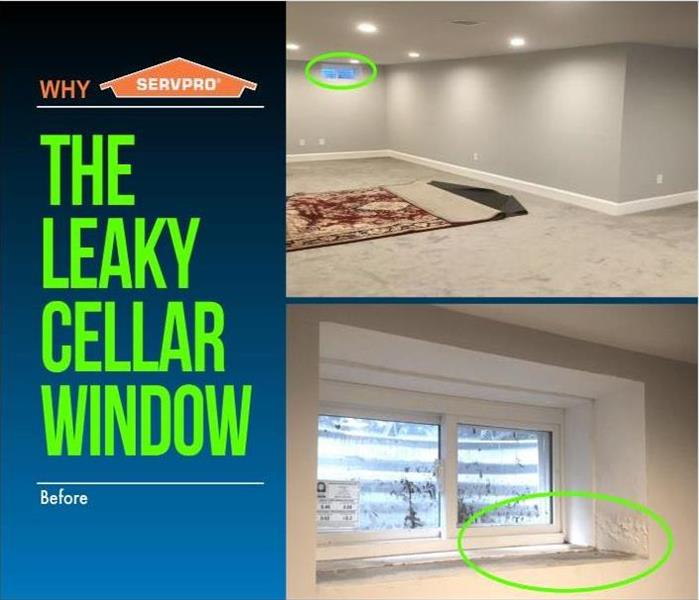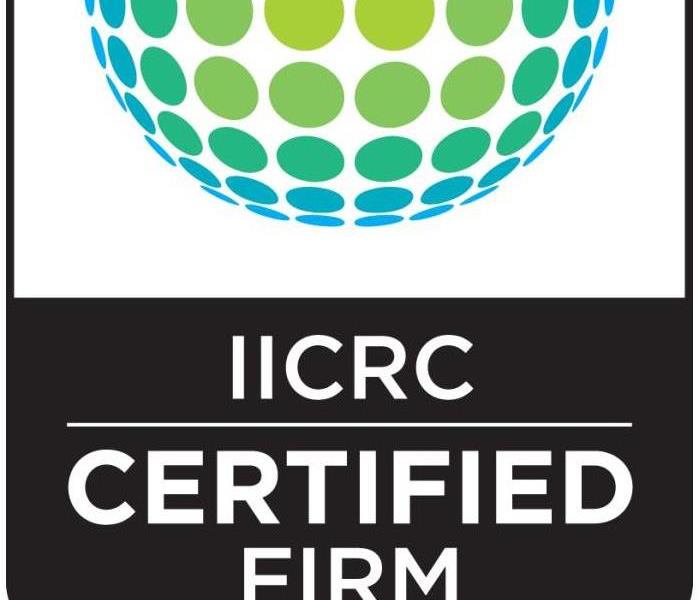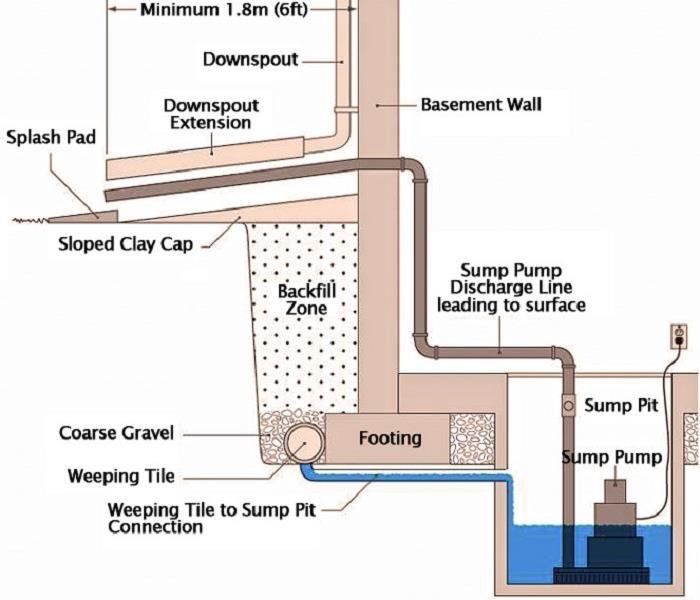Recent Water Damage Posts
Water Damage Assessment and Restoration Process in Foxborough, MA
4/9/2024 (Permalink)
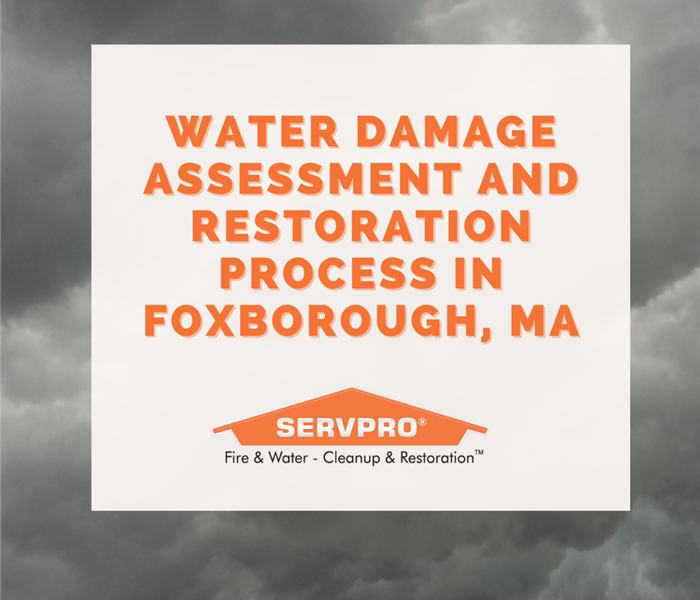 Don't let water damage disrupt your home or business operations. We can help!
Don't let water damage disrupt your home or business operations. We can help!
Water damage can rapidly wreak havoc on your home or business, leading to structural deterioration, mold growth, and potential health hazards. When it strikes, understanding the proper assessment and restoration process is crucial for effectively mitigating destruction and restoring your property. Let's break down the key steps involved.
Step 1: Inspection
The first step is a thorough inspection of the affected areas by trained professionals. Using specialized moisture meters and thermal imaging cameras, they'll identify the water source, assess the extent of damage, and determine the best restoration plan - even detecting hidden moisture pockets.
Step 2: Water Extraction
With the assessment complete, it's time to remove all standing water from the premises. Industrial-grade pumps, wet/dry vacuums, and other extraction equipment are employed to rapidly eliminate water from floors, carpets, and surfaces. Prompt removal prevents further spread and secondary damage.
Step 3: Drying
Once extracted, high-speed air movers and dehumidifiers are strategically placed to dry out the area and restore normal humidity levels. This process may take several days depending on the materials impacted and saturation levels.
Step 4: Restoration
With affected areas fully dried, restoration can begin. This involves repairing or replacing damaged drywall, flooring, structures and contents to return the property to its preloss condition - clean, safe and inhabitable.
The Importance of Rapid Response
Swift action is paramount when water damage occurs. Prolonged moisture can rapidly lead to compounding issues like mold growth, compromised structures, and potential health risks. By responding immediately and involving professionals, you minimize destruction and expedite the restoration process.
Don't let water damage disrupt your home or business operations. The trained experts at SERVPRO of Foxborough are prepared to swiftly respond and properly assess, extract, dry and restore your property. With our advanced equipment and proven techniques, we'll make water damage "Like it never even happened."
Service Areas
Franklin, MA | Millis, MA | Wrentham, MA | Foxborough, MA | Wethersfield, MA | Bellingham, MA | Norfolk, MA
Handling a Flood in Your House, Steps to Take for a Swift Recovery
3/27/2024 (Permalink)
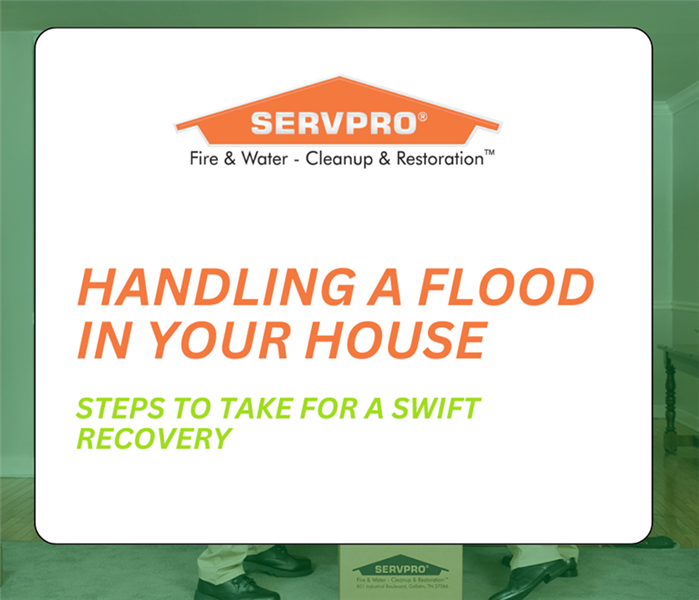 Knowing what steps to take in the aftermath of a flood can help you minimize damage and begin the recovery process.
Knowing what steps to take in the aftermath of a flood can help you minimize damage and begin the recovery process.
Experiencing a flood in your home in Foxborough, MA can be a devastating and overwhelming event. Whether it's from heavy rain, a burst pipe, or a malfunctioning appliance, a flood can cause extensive damage to your property and belongings. Knowing what steps to take in the aftermath of a flood can help you minimize damage and begin the recovery process. Here's a guide on what to do if you find yourself dealing with a flood in your house in Foxborough, MA
- Ensure Safety: Your safety should be the top priority. If floodwaters are still rising and pose a risk, evacuate immediately. Avoid walking or wading through floodwater, as it may be contaminated or hiding hazards.
- Turn Off Utilities: If it is safe to do so, turn off electricity, gas, and water to prevent further damage and reduce electrical hazards.
- Document the Damage: Take photos or videos of the floodwater and damage for insurance claims and restoration purposes.
- Remove Water: Use pumps, wet/dry vacuums, or buckets to remove standing water. Lingering water can lead to mold growth and more damage.
- Dry Out the Area: Use fans, dehumidifiers, and open windows to dry the area. Mold can grow quickly, so start drying as soon as possible.
- Remove Damaged Items: Dispose of unsalvageable items like furniture, carpets, and saturated drywall. Document them for insurance purposes before disposal.
- Clean and Disinfect: Thoroughly clean and disinfect surfaces that came into contact with floodwater. Use a bleach solution to kill bacteria and mold spores.
- Contact Your Insurance Company: Notify your insurance company of the flood damage and follow their instructions for filing a claim.
- Hire a Professional Restoration Company: Consider hiring professionals for cleanup and restoration. They have the expertise and equipment for effective restoration.
- Prevent Future Floods: After cleanup, take steps to prevent future floods, such as installing a sump pump or ensuring proper drainage.
SERVPRO Of Foxborough is The #1 Choice in Cleanup and Restoration for residential buildings’ fire, mold, water, and storm damage. We are ready to assist businesses in Franklin, MA | Millis, MA | Wrentham, MA | Foxborough, MA | Wethersfield, MA | Bellingham, MA | Norfolk, MA
Drowning in Damage in Foxborough? Trust Our Water Restoration Experts to Save the Day
2/8/2024 (Permalink)
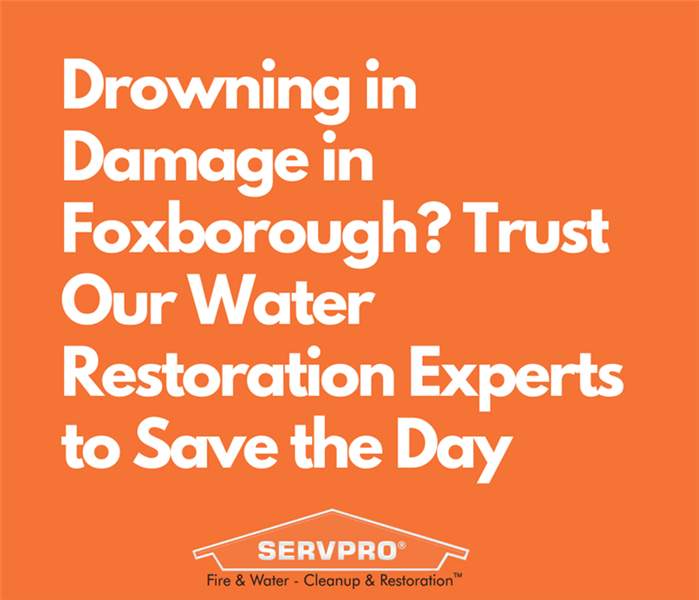 Water damage is a formidable challenge, but with the expertise of water restoration professionals, recovery is not only feasible but efficient.
Water damage is a formidable challenge, but with the expertise of water restoration professionals, recovery is not only feasible but efficient.
Water damage can strike suddenly, causing chaos and devastation in homes and businesses alike. Whether it's from a burst pipe, flooding, or a leaky roof, the aftermath of water damage can be overwhelming. In such challenging times, having a dependable team of water restoration experts is crucial to salvage your property and restore it to its former state. Let’s delve into the significance of professional water restoration services and why entrusting experts is essential for swift and effective recovery.
- Immediate Response to Prevent Further Damage: Time is of the essence when dealing with water damage. The longer water remains stagnant, the more severe the damage becomes. Professional water restoration experts comprehend the urgency and act swiftly to mitigate further damage. Their prompt intervention can prevent mold growth, structural issues, and other long-term repercussions.
- Thorough Assessment and Tailored Planning: Water damage restoration is a nuanced process that demands individualized attention. Each case requires a comprehensive assessment of the damage's extent. Experts meticulously inspect affected areas, identify potential risks, and devise a customized restoration plan. This ensures that every facet of the damage is addressed efficiently.
- Utilization of Advanced Equipment and Techniques: Professional water restoration teams utilize cutting-edge tools and techniques to tackle water damage effectively. Industrial-grade water extractors, dehumidifiers, and drying equipment are employed to eliminate excess water and moisture swiftly. This sophisticated equipment expedites the drying process and reduces the risk of secondary damage.
- Mold Remediation Expertise: One of the primary risks associated with water damage is mold growth, which can begin within 24-48 hours in damp conditions. Water restoration experts possess the knowledge and experience to detect and eradicate mold, ensuring a safe and healthy living or working environment.
- Efficient Insurance Coordination and Documentation: Dealing with insurance companies can be daunting and time-consuming. Water restoration professionals are adept at liaising with insurance providers. They assist in documenting the damage, providing accurate assessments, and streamlining the claims process, saving time and hassle for homeowners and business owners.
- Comprehensive Restoration Services: Professional restoration services extend beyond water extraction and drying. They encompass a wide array of tasks, including repairing structural damage, restoring damaged belongings, and ensuring overall property safety and functionality. A holistic approach guarantees that no aspect of the restoration process is overlooked.
- Peace of Mind for Property Owners: Dealing with water damage can be emotionally taxing. Hiring water restoration experts provides peace of mind, knowing that trained professionals are managing the situation. This allows property owners to focus on rebuilding and moving forward with confidence.
Water damage is a formidable challenge, but with the expertise of water restoration professionals, recovery is not only feasible but efficient. Trusting professionals to handle the restoration process ensures a thorough and effective response, offering the best chance to salvage your property and move beyond the damage. When faced with water-related woes, don't hesitate to rely on the expertise of water restoration professionals to save the day in Foxborough.
SERVPRO Of Foxborough is the premier choice in cleanup and restoration for residential and commercial buildings affected by fire, mold, water, and storm damage.
How Does Water Damage Start in Foxborough?
10/27/2023 (Permalink)
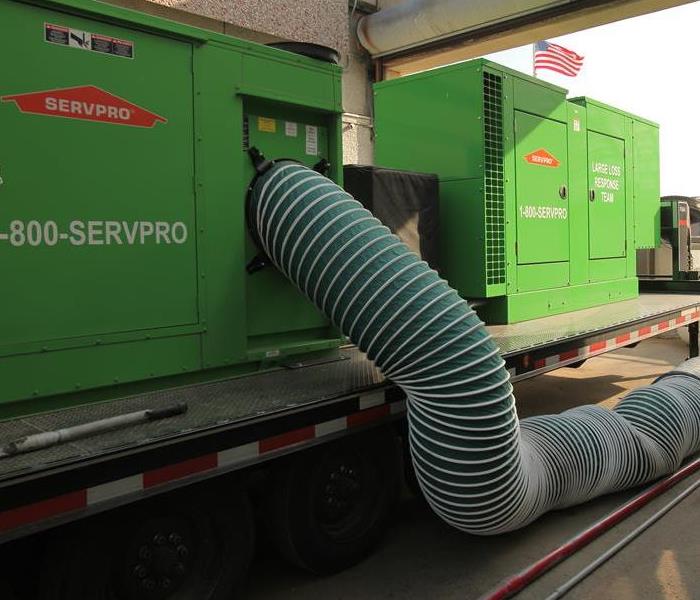 How Does Water Damage Start in Foxborough? Water doesn't stand a chance against SERVPRO Of Foxborough
How Does Water Damage Start in Foxborough? Water doesn't stand a chance against SERVPRO Of Foxborough
It is crucial to comprehend the origins of water damage to effectively prevent and intervene in a timely manner. Numerous factors can initiate water damage, each with a ripple effect on our homes:
- Leaky Roofs and Damaged Shingles: A compromised roof, often resulting from damaged or missing shingles, is a primary cause of water damage. Leaks in the roof permit water infiltration into the attic and other structural components, leading to the deterioration of wood, weakened ceilings, and eventual water stains on interior walls.
- Faulty Plumbing: Water damage is frequently initiated by leaky pipes, burst hoses, and faulty plumbing fixtures. Small, unnoticed leaks can escalate rapidly, causing harm to walls, flooring, and even the house's foundation. Regular inspections and prompt repairs are essential to mitigate risks associated with plumbing-related water damage.
- Clogged Gutters and Downspouts: Gutters and downspouts, crucial for directing rainwater away from the house, become problematic when clogged with debris. Overflowing water can saturate exterior walls, leading to structural damage, mold growth, and erosion around the foundation.
- Poorly Sealed Windows and Doors: Inadequately sealed windows and doors act as entry points for water, particularly during heavy rain or storms. Over time, water infiltration can result in rotting frames, damaged drywall, and compromised structural integrity. Regular inspections and resealing of these entry points are vital for preventing water damage.
- Basement Flooding: Basements, situated below ground level, are susceptible to water damage due to factors like heavy rainfall, poor drainage, or a high water table. Flooding can cause extensive damage to walls, flooring, and belongings stored in the basement.
- Appliance Leaks: Household appliances, including washing machines, dishwashers, and water heaters, may cause water damage if they develop leaks. Malfunctioning appliances or worn-out hoses can release water, damaging floors, walls, and nearby possessions.
Understanding that water damage can originate in diverse ways empowers homeowners to recognize signs and address root causes promptly. Regular maintenance, timely repairs, and a proactive approach to potential entry points for water can safeguard homes from the pervasive threat of water damage, ensuring a dry and secure living environment for years to come.
Water doesn't stand a chance against SERVPRO Of Foxborough commercial and residential remediation services. We're not just another remediation company; we're your partners in ensuring a safe, healthy environment. So, if you're facing a water problem, don't hesitate. You can reach a member of our team 24/7/365.
Preventing Ice Dams: A Guide to Protecting Your Home in Foxborough.
10/18/2023 (Permalink)
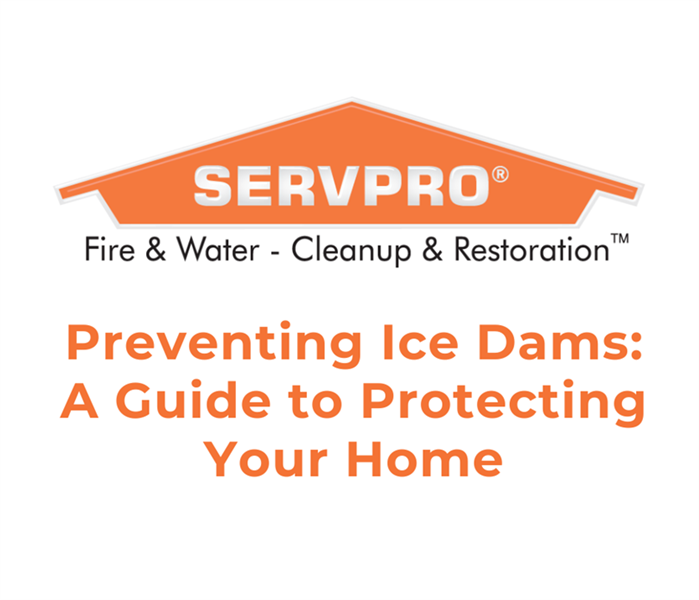 Proactively insulating your home, enhancing ventilation, and conducting regular maintenance significantly diminish the risk of ice dams.
Proactively insulating your home, enhancing ventilation, and conducting regular maintenance significantly diminish the risk of ice dams.
Winter possesses the potential for enchantment, yet it also introduces a set of challenges, particularly for homeowners in Foxborough, MA.
Among the prevalent and potentially detrimental issues in the winter months is the emergence of ice dams on rooftops. Safeguarding your home involves understanding what ice dams are, why they form, and, crucially, how to prevent them.
Comprehending Ice Dams
Ice dams manifest as ridge-like accumulations of ice along the roof's edge, impeding the drainage of melting snow and ice. This can lead to water backup and potential infiltration into your home. The process typically unfolds as follows:
- Snow Accumulation: Your roof becomes blanketed in a layer of snow.
- Heat Loss: The heat from your home escapes through the roof, causing snow on the upper section to melt.
- Freezing Point: As the melted water reaches the colder lower section of the roof, it refreezes, forming an ice dam.
- Water Backup: Ongoing snowmelt flows towards the ice dam, creating a pool of water that may find its way into your home through roof or siding gaps.
Significance of Preventing Ice Dams
Ice dams can wreak havoc on your home in multiple ways:
- Roof Damage: The weight of ice dams can harm the roof's structure and shingles, necessitating costly repairs.
- Water Damage: Trapped water on the roof can infiltrate your home, causing extensive damage to ceilings, walls, and insulation.
- Mold and Mildew: Moisture infiltration fosters mold and mildew growth, posing health risks.
- Energy Loss: Ice dams often form due to escaping heat, resulting in energy loss and increased heating bills.
Understanding the risks, here are practical steps to prevent ice dams:
- Proper Insulation: Ensure adequate attic insulation to maintain a uniform roof temperature.
- Ventilation: Install roof and soffit vents for consistent attic air circulation.
- Seal Gaps: Seal openings in the roof, walls, and attic to minimize warm air leakage.
- Attic Air Sealing: Prevent warm air from escaping into the attic space.
- Roof Raking: After heavy snowfall, use a roof rake to remove excess snow, reducing the potential for melting.
- Ice Dam Membranes: Consider installing an ice and water shield membrane to prevent water infiltration.
- Gutter Maintenance: Keep gutters clean and install heated cables to prevent ice buildup.
- Professional Inspection: Schedule regular roofing inspections to address issues before they escalate.
Proactively insulating your home, enhancing ventilation, and conducting regular maintenance significantly diminish the risk of ice dams. This not only preserves your home's integrity but also controls energy costs, ensuring a warm and dry winter in Norfolk, MA. Prevention now can save considerable trouble and expense in the future. Embrace the winter season warmly, dryly, and to the fullest!
SERVPRO® Of Foxborough is The #1 Choice in Cleanup and Restoration for residential and commercial buildings’ fire, mold, water, and storm damage. Call us today at (508) 533-5305.
Dealing with Water Damage: A Comprehensive Guide
9/27/2023 (Permalink)
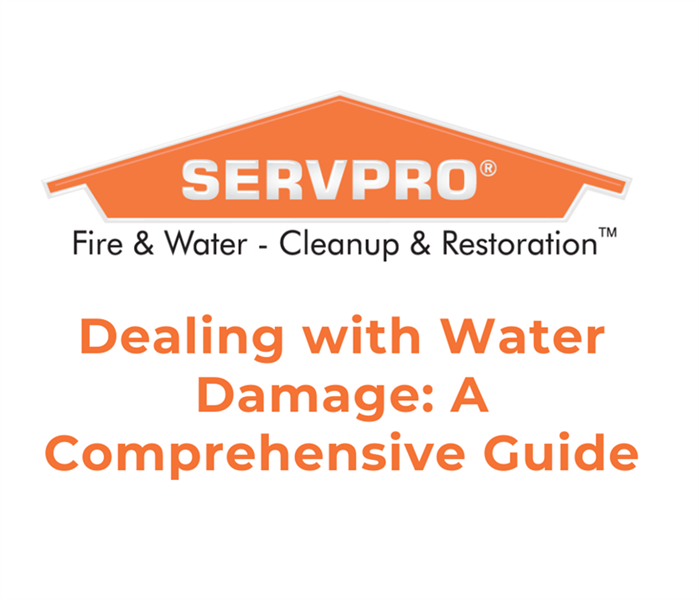 With the right knowledge and quick action, you can minimize water damage and ensure a smoother recovery process.
With the right knowledge and quick action, you can minimize water damage and ensure a smoother recovery process.
With the right knowledge and quick action, you can minimize water damage and ensure a smoother recovery process. Here are the essential steps to take when faced with water damage.
Ensure Safety First: Before you start dealing with water damage, prioritize safety. Turn off the power to the affected area to avoid electrical hazards. If necessary, wear protective gear such as rubber gloves and waterproof boots to prevent contact with contaminated water.
Identify the Source and Stop It: Determine the source of the water and take immediate steps to stop it. If it's a burst pipe, turn off the water supply to that area or the entire house. For roof leaks, place buckets or tarps to divert water away from the damaged area temporarily. If the water source is external (like a flood), wait for authorities to confirm it's safe before returning.
Document the Damage: Take photographs or videos of the water damage before you begin cleanup or contact your insurance company. Proper documentation can help support your insurance claim.
Call Your Insurance Company: Contact your homeowner's insurance provider as soon as possible to report the water damage. Provide them with all the necessary information, including photos and videos, so they can initiate the claims process.
Remove Water and Moisture: The longer water sits, the more damage it can cause. Begin the drying process immediately by removing excess water using pumps, wet/dry vacuums, or towels. Open windows and doors to encourage ventilation and help speed up the drying process.
Salvage Valuables: Remove valuable and sentimental items from the affected area to prevent further damage. Furniture, electronics, and personal belongings should be relocated to a dry and safe place.
Prevent Mold Growth: Mold can start growing within 24 to 48 hours after water damage occurs. To prevent mold growth, thoroughly dry and disinfect the affected area. Use fans and dehumidifiers to reduce humidity levels, and consider using mold-resistant products during repairs.
Assess Structural Damage: Check for any structural damage that may have occurred due to the water. This includes inspecting walls, ceilings, floors, and the foundation. If you suspect structural issues, consult with a professional contractor or engineer.
Repair and Restore: Once the affected area is completely dry, you can start the repair and restoration process. Depending on the extent of the damage, you may need to replace drywall, insulation, flooring, or other structural components.
Prevent Future Water Damage: After the cleanup and restoration are complete, take steps to prevent future water damage. Regularly inspect your home for leaks, maintain your plumbing system, and consider installing a sump pump or backflow preventer if you're in a flood-prone area.
Dealing with water damage can be stressful, but by following these steps and acting quickly, you can minimize the damage and ensure a smoother recovery process. Remember that safety should always be your top priority, and seeking professional help when needed can make a significant difference in the outcome. With proper precautions and a well-executed plan, you can restore your home to its former glory and safeguard it against future water damage.
SERVPRO Of Foxborough is The #1 Choice in Cleanup and Restoration for residential and commercial buildings’ fire, mold, water, and storm damage. If you are looking for assistance, just click on the contact us page, and someone will be in touch shortly.
Protect Your Home Against a Flood in Foxborough, MA: Essential Tips to Safeguard Your Abode
8/16/2023 (Permalink)
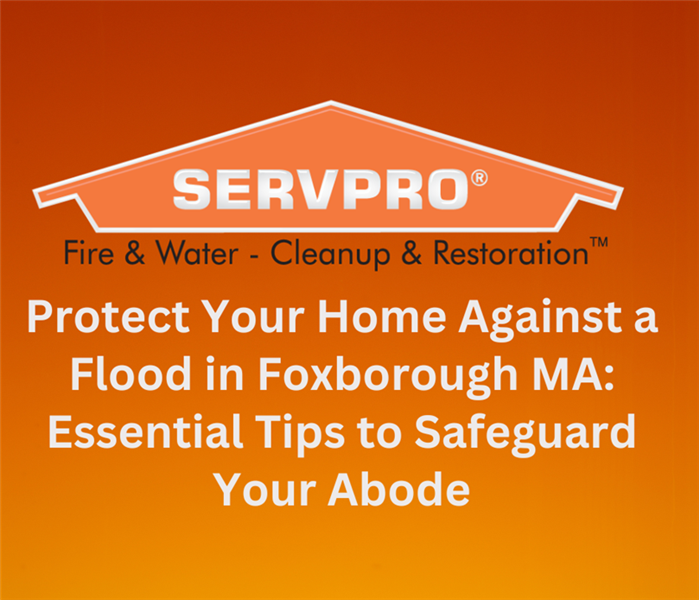 SERVPRO of Foxborough provides Cleanup and restoration services for fire, mold, water, and storm damage in both residential and commercial buildings
SERVPRO of Foxborough provides Cleanup and restoration services for fire, mold, water, and storm damage in both residential and commercial buildings
Floods are among the most destructive and devastating natural disasters. Here are some essential tips and strategies to safeguard your home and loved ones from the destructive force of floods.
- Understand the Flood Risk in Your Area: Check local flood maps and seek information from relevant authorities about historical flood events in your region.
- Elevate Electrical Systems: Hire a professional electrician to elevate all electrical outlets, switches, sockets, and wiring above the expected flood levels.
- Waterproof Your Basement: Seal any cracks in the foundation and walls to prevent water seepage. Consider installing a sump pump to remove any accumulated water.
- Elevate Appliances and Furnishings: Raise your valuable appliances, including washers, dryers, water heaters, and furnaces, on elevated platforms to keep them above potential floodwaters.
- Install Flood Barriers and Sandbags: Temporary flood barriers and sandbags can act as a first line of defense during a flood event.
- Secure Sewage Backflow Valves: During severe floods, there's a risk of sewage backflow, which can lead to contamination and further damage. Installing sewage backflow valves in your home's plumbing system can help prevent sewage from entering your property.
- Create Adequate Drainage: Ensure that your property has proper drainage systems in place to direct water away from your home's foundation. Clean gutters, downspouts, and drains regularly to prevent blockages that may lead to water pooling around your home.
- Elevate Outdoor Utilities: Outdoor utilities such as air conditioning units and fuel tanks should be raised above potential flood levels to minimize damage and reduce safety risks.
- Purchase Flood Insurance: It's essential to invest in separate flood insurance coverage to protect your home and belongings in case of a flood event.
While we cannot control natural disasters like floods, we can take proactive steps to protect our homes and loved ones from their devastating effects. By understanding the flood risk in our area and implementing flood protection measures, we can significantly reduce the potential impact of floods on our homes.
When it comes to cleanup and restoration services for fire, mold, water, and storm damage in both residential and commercial buildings, SERVPRO of Foxborough takes pride in being the number one choice. Our dedicated services cover a wide range of areas, including Bellingham, Foxborough, Franklin, Millis, Norfolk, Wethersfield, and Wrentham, MA. Count on us for unparalleled expertise and prompt solutions to bring your property back to its original condition.
Restoring Brilliance: A Comprehensive Guide to Rebuilding After Water Damage
7/7/2023 (Permalink)
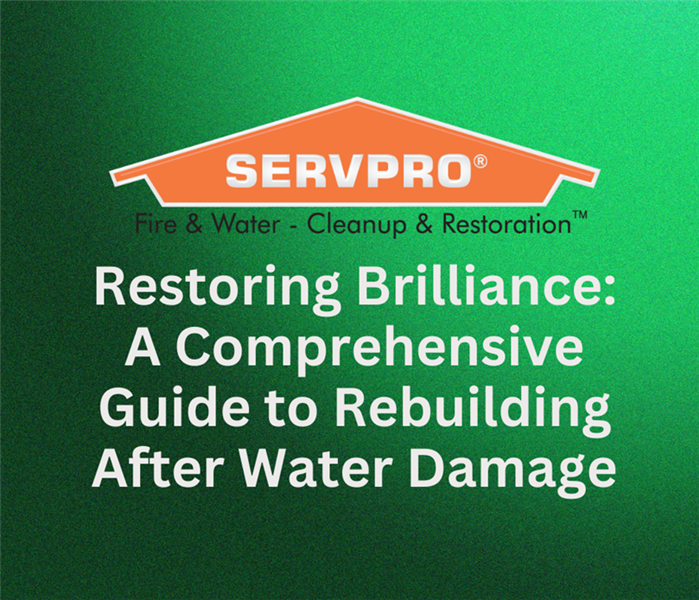 Rebuilding a building after water damage requires careful planning, meticulous execution, and collaboration among various professionals.
Rebuilding a building after water damage requires careful planning, meticulous execution, and collaboration among various professionals.
Recovering from water damage can have devastating effects on a building, impacting its structural integrity, functionality, and overall appearance. Whether the damage is caused by floods, burst pipes, or leaks, it is crucial to take immediate action and plan the restoration process carefully. Let's explore a step-by-step guide on how to rebuild a building after water damage, ensuring a safe, efficient, and visually appealing transformation.
Step 1: Assessing the Damage: Before beginning the rebuilding process, it is essential to conduct a thorough assessment of the water damage. Engage the services of a professional inspector or a reputable restoration company to determine the extent of structural, electrical, and mold-related damage. This assessment will provide crucial insights to effectively plan the restoration process.
Step 2: Ensuring Safety: Safety should always be the top priority when working on a building affected by water damage. Before entering the premises, ensure that the electrical power is shut off to prevent potential hazards. Take necessary precautions to avoid slips, falls, and exposure to contaminated water. Utilize appropriate personal protective equipment (PPE) such as gloves, masks, and boots.
Step 3: Water Extraction and Drying: Removing the water is a critical step in the restoration process. Utilize industrial-grade pumps, wet vacuums, and dehumidifiers to extract standing water from the affected areas. Promote proper air circulation by opening windows, using fans, and employing specialized drying equipment. It is imperative to eliminate excess moisture to prevent mold growth and further damage to the structure.
Step 4: Mold Remediation: Moisture-laden environments provide ideal conditions for mold growth. If mold is detected, consult with professionals experienced in mold remediation. They will assess the extent of mold contamination, perform thorough cleaning, and ensure proper ventilation to prevent future mold outbreaks. Taking prompt action will safeguard the health of occupants and maintain the integrity of the building.
Step 5: Structural Repairs: Once the affected areas are dry and free of mold, it's time to address the structural damage. Engage the services of qualified contractors or construction professionals to repair weakened walls, floors, ceilings, and the foundation. Reinforce compromised structures, replace damaged materials, and ensure compliance with building codes and regulations. Conduct necessary plumbing repairs and inspections to prevent future water-related issues.
Step 6: Electrical and HVAC Systems: Water damage can severely impact electrical and HVAC systems, posing potential safety hazards. Engage licensed electricians and HVAC technicians to thoroughly inspect, repair, or replace damaged components. Ensure that all systems meet safety standards and regulations before reconnecting utilities.
Step 7: Interior Restoration: The rebuilding process also involves restoring the interior spaces to their former condition. Assess and replace damaged insulation, drywall, flooring, and fixtures. Repaint walls, applying mold-resistant coatings where necessary. Consider utilizing waterproof materials for future protection. Consult interior designers or decorators to create functional and aesthetically pleasing spaces.
Step 8: Prevention and Preparedness: To mitigate the risk of future water damage, implement preventive measures. Install water detection systems, reinforce waterproofing measures, and regularly inspect plumbing and roof systems. Educate occupants on proactive steps to prevent water-related accidents and encourage immediate reporting of leaks or other issues.
Rebuilding a building after water damage requires careful planning, meticulous execution, and collaboration among various professionals. By following this comprehensive guide, you can navigate the restoration process with confidence, ensuring the safety, functionality, and beauty of the rebuilt structure.
If you're in need of cleanup and restoration services for residential or commercial buildings affected by fire, mold, water, or storm damage, consider contacting SERVPRO Of Foxborough. They are the #1 choice in cleanup and restoration, serving Bellingham, Foxborough, Franklin, Millis, Norfolk, Wethersfield, and Wrentham, MA.
What happens if I don’t fix the water damage?
4/18/2023 (Permalink)
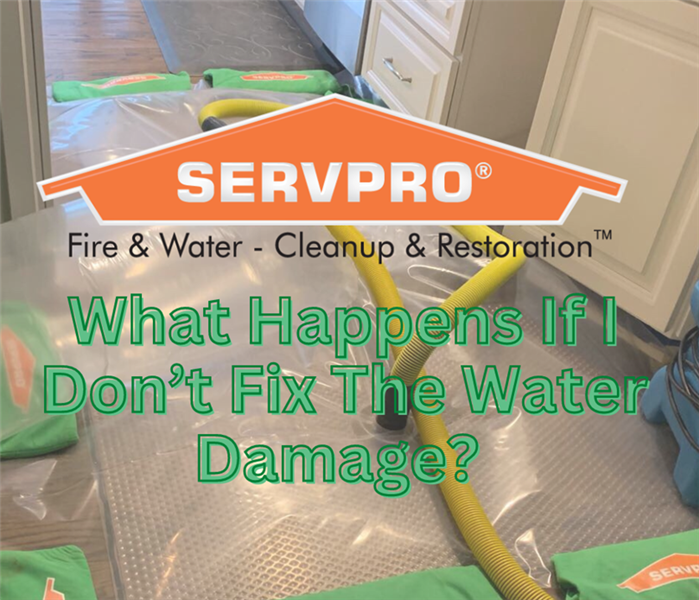 It is important to seek professional help to repair and restore your home to its pre-damaged condition.
It is important to seek professional help to repair and restore your home to its pre-damaged condition.
Water damage can be caused by a variety of factors. If not addressed promptly, water damage can cause significant problems for your home and your health.
- Structural damage: Water can weaken the structural integrity of your home, causing warping, cracking, and even collapse of your floors, walls, and ceilings.
- Mold growth: Water damage creates a perfect environment for mold to grow, which can lead to serious health problems such as respiratory issues and allergies.
- Electrical hazards: Water can cause electrical wiring to malfunction or even short circuit, which can cause fires and pose a serious risk to your safety.
- Odor: Water damage can cause unpleasant odors to develop, which can be difficult to eliminate without professional remediation.
- Pest infestations: Water damage can attract pests such as rodents and insects, which can thrive in damp environments and cause further damage to your home.
- Decreased property value: If left unprepared, water damage can decrease the value of your home and make it difficult to sell in the future.
- Health hazards: Water damage can create a breeding ground for bacteria and viruses, which can pose a serious health risk to you and your family.
It is important to seek professional help to repair and restore your home to its pre-damaged condition.
We service Bellingham, Foxborough, Franklin, Millis, Norfolk, Wethersfield, and Wrentham, MA
SERVPRO Of Foxborough is The #1 Choice in Cleanup and Restoration for residential and commercial buildings’ fire, mold, water, and storm damage.
How long does it take for water damage to be fixed?
3/21/2023 (Permalink)
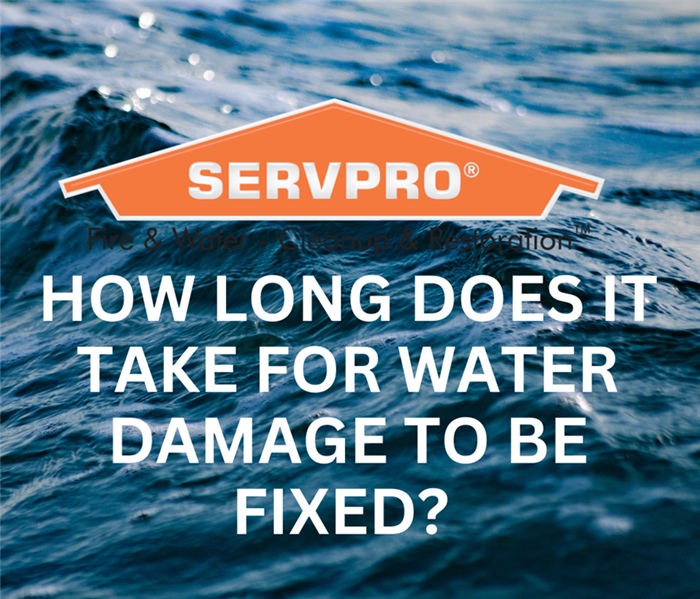 Water damage is a common problem that many homeowners face.
Water damage is a common problem that many homeowners face.
Water damage is a common problem that many homeowners face. It can be caused by a variety of factors such as leaks, flooding, and burst pipes. Water damage can have severe consequences if not fixed promptly.
In minor cases, such as a small leak, the damage can be fixed within a few hours or a day. However, for more severe cases such as a flooded basement, it can take several days or even weeks to fix the damage.
- The first step in fixing water damage is to identify the source of the water and stop it from causing further damage. This may involve shutting off the main water supply or fixing a broken pipe. Once the source of the water has been identified and fixed, the water damage restoration process can begin. The restoration process typically involves several stages, including water extraction, drying, and repair. The amount of time it takes to complete each stage depends on the extent of the damage.
- Drying is the next stage, and it involves removing any remaining moisture from the affected area. This can be done using dehumidifiers and fans. The duration of this stage depends on the extent of the water damage and the humidity levels in the affected area.
- Once the area has been dried, repairs can begin. This may involve replacing drywall, flooring, and other materials that were damaged by the water. The duration of this stage depends on the extent of the damage and the materials that need to be replaced.
If you experience water damage, it is best to contact a professional restoration company to ensure that the damage is fixed properly and efficiently.
We service Bellingham, Foxborough, Franklin, Millis, Norfolk, Wethersfield, and Wrentham, MA
SERVPRO Of Foxborough is The #1 Choice in Cleanup and Restoration for residential and commercial buildings’ fire, mold, water, and storm damage.
What are the steps for water damage in Foxborough MA?
3/5/2023 (Permalink)
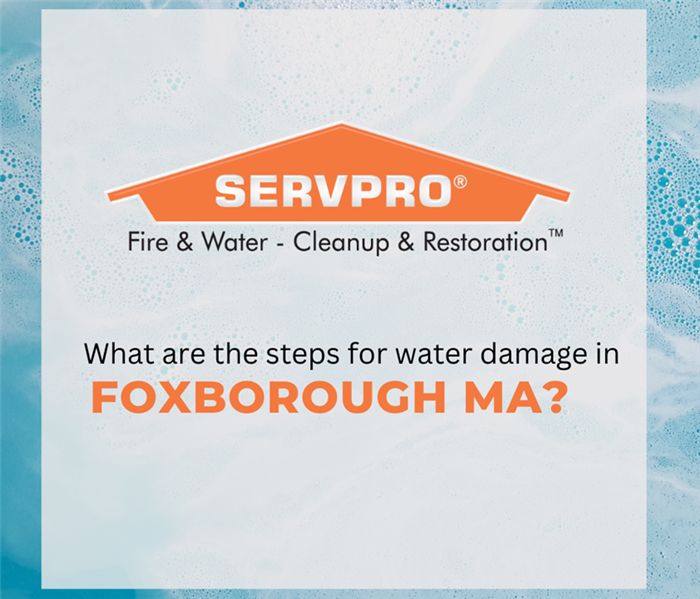 If the damage is extensive, it's best to hire a professional restoration company to ensure your home is restored to its pre-damaged condition.
If the damage is extensive, it's best to hire a professional restoration company to ensure your home is restored to its pre-damaged condition.
Water damage can be one of the most destructive problems a homeowner can face. Whether it's due to a burst pipe, a leaking roof, or flooding, water damage can cause extensive damage to your home, furniture, and personal belongings.
Ensure your safety: The first step in dealing with water damage is to ensure your safety. If the water damage is severe, turn off the electricity, gas, and water supply to your home before entering the affected area.
Document the damage: Before you start cleaning up the water, it's essential to document the damage for insurance purposes. Take pictures and videos of the damage to your home, furniture, and personal belongings.
Remove standing water: The next step is to remove any standing water as quickly as possible. You can use a wet/dry vacuum to remove the water or hire a professional restoration company to do the job for you.
Dry out the affected area: After removing the standing water, the next step is to dry out the affected area. You can use fans and dehumidifiers to speed up the drying process. If the water damage is extensive, it's best to hire a professional restoration company.
Clean and disinfect: Once the affected area is completely dry, it's essential to clean and disinfect the area to prevent mold growth.
Repair and restore: The final step is to repair and restore any damage. This may include replacing drywall, flooring, or furniture.
If the damage is extensive, it's best to hire a professional restoration company to ensure your home is restored to its pre-damaged condition.
We service Bellingham, Foxborough, Franklin, Millis, Norfolk, Wethersfield, and Wrentham, MA
SERVPRO Of Foxborough is The #1 Choice in Cleanup and Restoration for residential and commercial buildings’ fire, mold, water, and storm damage.
What Causes Flooding in homes and buildings?
2/15/2023 (Permalink)
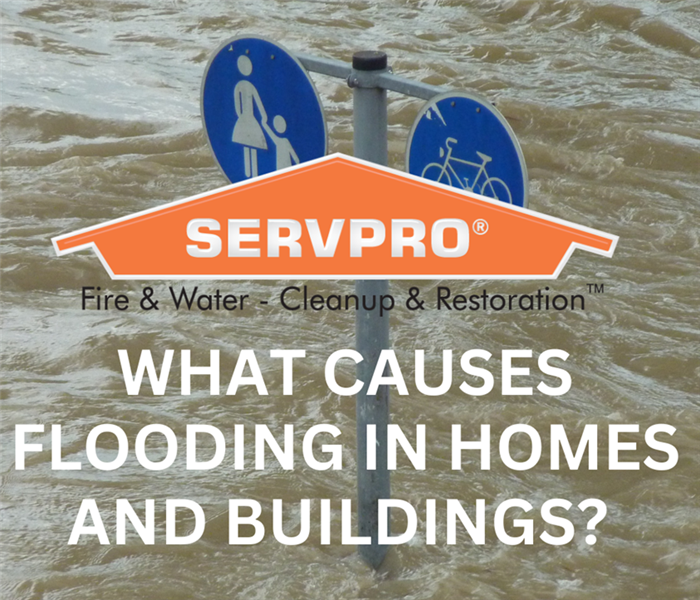 It is important to ensure that communities are prepared for flooding
It is important to ensure that communities are prepared for flooding
Flooding is a natural disaster that occurs when an area is overwhelmed by water, either from heavy rainfall or rising bodies of water. It can cause significant damage.
Causes of Flooding
Flooding can be caused by a variety of factors, including natural events and human activities. The most common natural cause of the flooding is heavy rainfall, particularly during prolonged periods of wet weather. This can lead to rivers and streams overflowing their banks, and low-lying areas becoming flooded.
Flooding can also be caused by rising sea levels, as well as coastal storms and hurricanes. These events can cause significant damage to coastal communities, particularly those in low-lying areas.
Human activities can also contribute to flooding. For example, the construction of buildings and other infrastructure can alter the natural flow of water, leading to increased flooding. Deforestation and other land use changes can also contribute to flooding, as they reduce the ability of soil to absorb water.
Impacts of Flooding
Flooding can have significant impacts on individuals, communities, and economies. The most immediate impact is damage to homes, businesses, and infrastructure, such as roads and bridges. This can result in the displacement of residents, loss of livelihoods, and disruption of essential services.
Flooding can also have long-term impacts on the environment. For example, it can lead to soil erosion, which can reduce the fertility of agricultural land. It can also lead to water pollution, as floodwaters can carry contaminants into rivers and other bodies of water.
Finally, flooding can have significant economic impacts. In addition to the direct costs of repairing damage to infrastructure and homes, flooding can also disrupt supply chains and reduce economic activity in affected areas.
Measures to Mitigate the Effects of Flooding
There are a number of measures that can be taken to mitigate the effects of flooding. One approach is to implement natural solutions, such as restoring wetlands and other natural features that help to absorb and slow down floodwaters. This can help to reduce the impact of flooding on communities and the environment.
Another approach is to implement engineered solutions, such as building flood protection infrastructure like levees, flood walls, and stormwater management systems. These measures can help to prevent flooding in the first place, or to reduce the impact of flooding when it does occur.
Finally, it is important to ensure that communities are prepared for flooding. This can involve measures such as developing early warning systems, establishing emergency shelters, and educating residents on how to prepare for and respond to flooding events.
By understanding the causes and impacts of flooding, and implementing measures to mitigate its effects, we can work to protect our communities and reduce the impact of this devastating natural event.
SERVPRO of Foxborough is your premier choice for fire damage and restoration. Our teams are ready to respond 24 hours a week, any day of the year. When you bring us on the job our team of licensed contractors and certified technicians will work collaboratively with you throughout the duration of the project. They will keep you updated on the project's status and ensure that your expectations are met. We will help you to move forward and make it “Like it never even happened” for all of your fire damage.
SERVPRO of Foxborough Discusses How To Prevent Flooding in a Basement
2/5/2023 (Permalink)
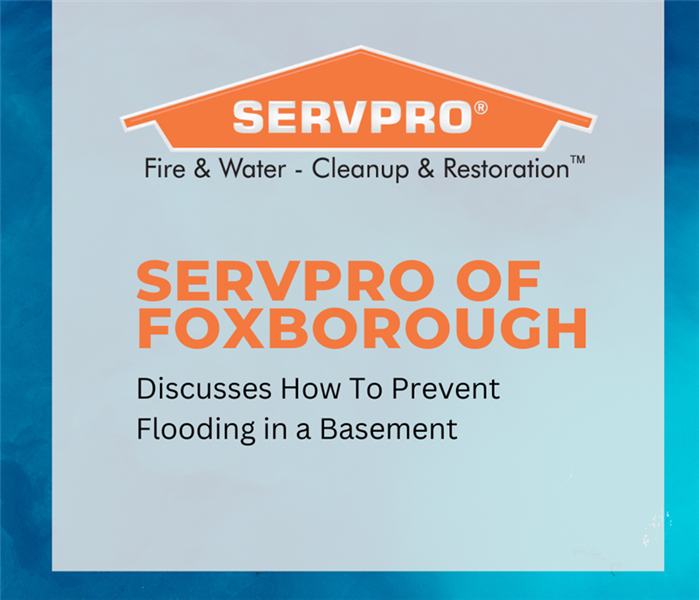 Flooding in a basement can be a stressful and devastating experience. It can cause extensive damage to your property
Flooding in a basement can be a stressful and devastating experience. It can cause extensive damage to your property
Flooding in a basement can be a stressful and devastating experience. It can cause extensive damage to your property and belongings, and if not addressed promptly, it can also lead to mold growth.
There are many reasons why a basement can flood. Some common causes include:
- Heavy rainfall: When there is an excessive amount of rainfall in a short period of time, it can cause water to seep into the basement through cracks in the foundation, windows, or doorways.
- Overflowing gutters and downspouts: If your gutters and downspouts are clogged, water will overflow and can seep into the basement.
- Sewer backup: A sewer backup occurs when wastewater from the sewer system enters your basement. This can be caused by a blockage in the sewer line, heavy rainfall, or a malfunction in the sewage system.
- High water table: If the water table is high in your area, it can cause water to seep into the basement through the walls or floor.
To prevent basement flooding, there are several steps you can take:
- Install a sump pump: A sump pump is a device that pumps water out of the basement when it reaches a certain level.
- Check your gutters and downspouts regularly: Make sure they are clear of debris and are directing water away from the foundation of your home.
- Install backflow valves: Backflow valves prevent sewer water from flowing back into your home.
- Seal cracks in the foundation: If you find cracks in the foundation of your home, have them sealed to prevent water from seeping in.
If your basement is flooded, it's important to take immediate action to prevent further damage and to mitigate any health risks:
- Turn off the electricity: If water has entered your basement, turn off the electricity to prevent electrical shock.
- Remove water: If the water level is not too high, use a pump or wet vacuum to remove the water. If the water level is too high, call a professional to remove the water.
- Clean and dry everything: Once the water has been removed, clean and dry all the items in the basement. This includes walls, floors, furniture, and other belongings.
- Call in professionals: If the damage is extensive, it's best to call in a professional to assess the damage and make any necessary repairs.
Basement flooding can be a stressful and devastating experience, but by taking the steps to prevent it and knowing what to do if it occurs, you can minimize the damage and health risks associated with it.
SERVPRO of Foxborough is your premier choice for fire damage and restoration. Our teams are ready to respond 24 hours a week, any day of the year. When you bring us on the job our team of licensed contractors and certified technicians will work collaboratively with you throughout the duration of the project. They will keep you updated on the project's status and ensure that your expectations are met. We will help you to move forward and make it “Like it never even happened” for all of your fire damage.
SERVPRO of Foxborough Shares Causes of a Flooded Basement.
1/7/2023 (Permalink)
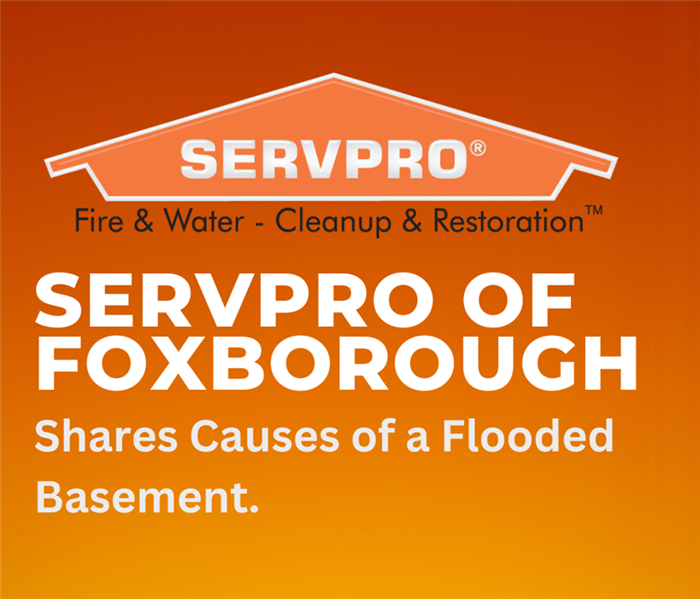 A flooded basement can occur anytime, especially from weather-related events such as heavy rainfall or rapid snowmelt to older homes.
A flooded basement can occur anytime, especially from weather-related events such as heavy rainfall or rapid snowmelt to older homes.
A flooded basement can occur anytime, especially from weather related events such as heavy rainfall or rapid snowmelt to older homes.
- Foundation cracks
- Broken basement windows
- Poor-draining window wells
- Sewer system problems
- Sump pump problems
- Improperly sealed basement walls
- House located at the bottom of a slope
- Weeping tile blockage
- Overflowing rain gutters
- Improper downspout locations
- Appliance leaks
- Water heater failure
Proper home maintenance can prevent the problems. Make sure to check rain gutters and remove all debris, and seal cracks in your foundation.
SERVPRO of Foxborough is your premier choice for water damage and restoration. Our teams are ready to respond 24 hours a week, any day of the year. When you bring us on the job our team of licensed contractors and certified technicians will work collaboratively with you throughout the duration of the project. They will keep you updated on the project's status and ensure that your expectations are met. We will help you to move forward and make it “Like it never even happened” for all of your water damage.
SERVPRO of Foxborough Shares Frozen Pipe Information
12/5/2022 (Permalink)
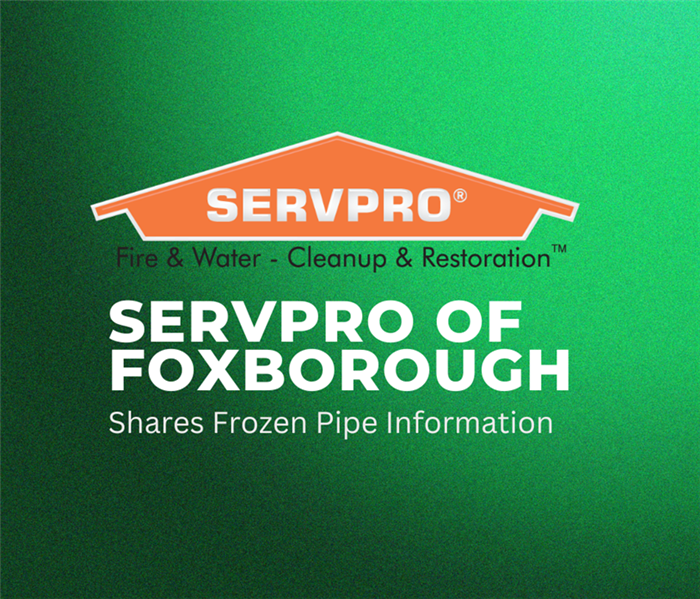 If you are unsure about frozen pipes, make sure to call for assistance. We are open 24/7 and are happy to assist.
If you are unsure about frozen pipes, make sure to call for assistance. We are open 24/7 and are happy to assist.
Winter months call for frozen pipes. It is important to know and understand what this means to prevent damage to your building.
Pipes will eventually unfreeze on their own naturally. However, this takes time and could actually lead to the pipe bursting.
Here is what you should do if you suspect you have frozen pipes.
- Check with a neighbor to see if they’re experiencing frozen pipes too. If they have running water, it’s likely your pipes have frozen.
- Turn off the water immediately using the main shut-off valve.
- Open the faucet for water to flow through the pipe once the area is melted.
- Apply heat around the pipe using a hair dryer. Keep all heat sources away from flammable materials.
- Once pipes are thawed, you can turn the water back on and check all joints for leaks.
- Check all pipes and joints for leaks or cracks.
If there are still issues, do not wait to address them, and contact an experienced water restoration company.
If you are unsure about frozen pipes, make sure to call for assistance. We are open 24/7 and are happy to assist.
SERVPRO of Foxborough is your premier choice for water damage and restoration. Our teams are ready to respond 24 hours a week, any day of the year. When you bring us on the job our team of licensed contractors and certified technicians will work collaboratively with you throughout the duration of the project. They will keep you updated on the project's status and ensure that your expectations are met. We will help you to move forward and make it “Like it never even happened” for all of your water damage.
SERVPRO of Foxborough Explains Fall Storm Safety
10/5/2022 (Permalink)
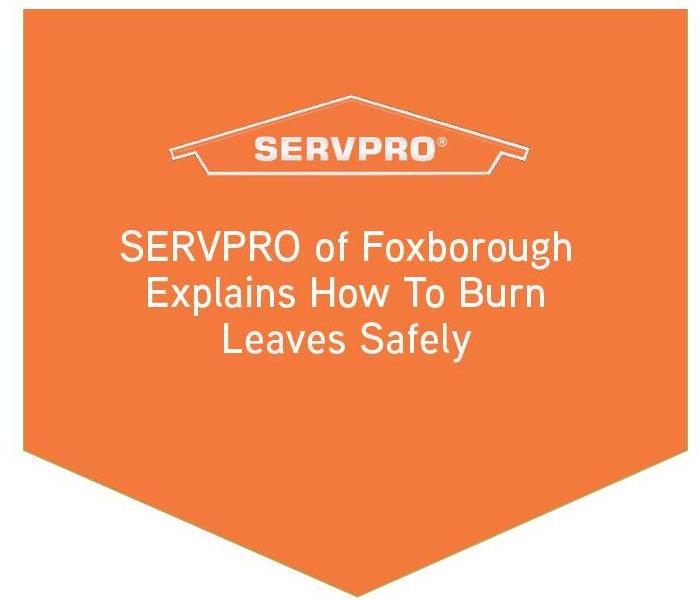 Falling leaves are often the first signs of the fall season. As the piles of raked leaves build up, many are faced with how to dispose of them!
Falling leaves are often the first signs of the fall season. As the piles of raked leaves build up, many are faced with how to dispose of them!
Falling leaves are often the first signs of the fall season. As the piles of raked leaves build up, many are faced with how to dispose of them!
People like to burn leaves or throw trash onto piles, such as household garbage, construction debris, or old papers. This can actually cause more damage than good.
Burning materials such as yard waste, grass clippings, and leaves may be permissible depending on your town’s ordinances. If you decide to burn leaves, do not use flammable liquids to ignite the debris. Keep an eye on the fire at all times and be prepared to extinguish it at any moment. Safety should always be the number one concern.
There are plenty of safe alternatives for you to do instead of burning leaves.
- You can recycle tree limbs, grass clippings, and leaves.
- You can also compost items into mulch or chipped them into landscaping material.
- Many cities and towns provide a curbside collection of bagged leaves. Check with your local public works department.
- Call a yard waste or junk removal service, they will take the debris to the dump or recycling center.
There are plenty of ways to get rid of your leaves this fall, it just depends on what works best for you. Remember safety first.
SERVPRO of Foxborough is your premier choice for restoration and rebuilding. Our teams are ready to respond 24 hours a week, any day of the year. When you bring us on the job our team of licensed contractors and certified technicians will work collaboratively with you throughout the duration of the project. They will keep you up to date on the status of the project and make sure that your expectations are met. We will help you to move forward and make it “Like it never even happened” for all of your storm damage.
SERVPRO of Foxborough Shares Ice Safety Tips
12/7/2021 (Permalink)
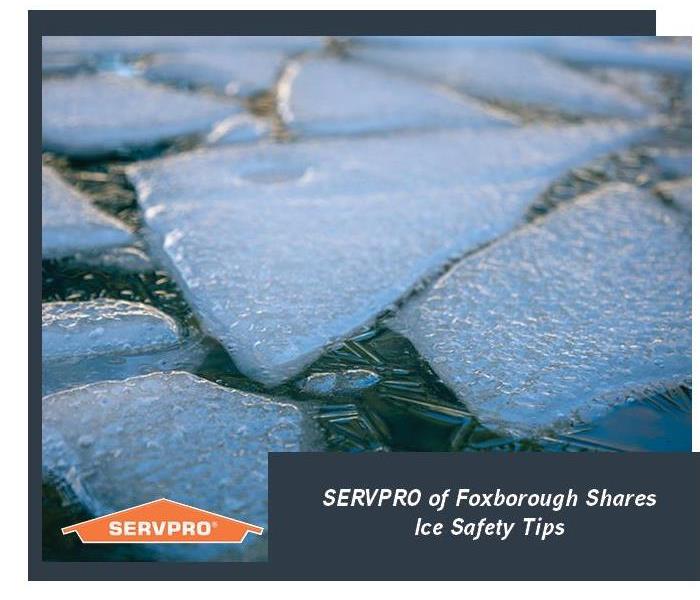 Ice and ice storms can cause a lot of damage to you, and your home. Make sure to take as many precautions as possible if there is a warning for ice.
Ice and ice storms can cause a lot of damage to you, and your home. Make sure to take as many precautions as possible if there is a warning for ice.
During the winter months, ice safety is a concern for many. A lot of times, we can’t always prepare as quickly as we’d like for ice since the weather is unpredictable. It is important to know the basics and be sensible. Everybody needs to be careful around frozen lakes, rivers, and streams.
There are several steps you can take to stay ice smart:
- Keep away from unfamiliar paths.
- Avoid traveling at night, it is hard to see black ice.
- Never go on the ice alone. Have a buddy with you that can assist you should the need arise.
- Have an emergency kit handy. The kit should include lighter, waterproof matches, magnesium fire starter, pocketknife, compass.
- For your home, make sure to winterize your pipes
- Make sure to prepare for a power outage if there is a winter storm advisory.
Ice and ice storms can cause a lot of damage to you, and your home. Make sure to take as many precautions as possible if there is a warning for ice.
SERVPRO of Foxborough is available 24/7 including holidays and weekends to assist you with disasters. “Like it never even happened.”
SERVPRO of Foxborough Helps Prepare For Water Damage.
11/17/2021 (Permalink)
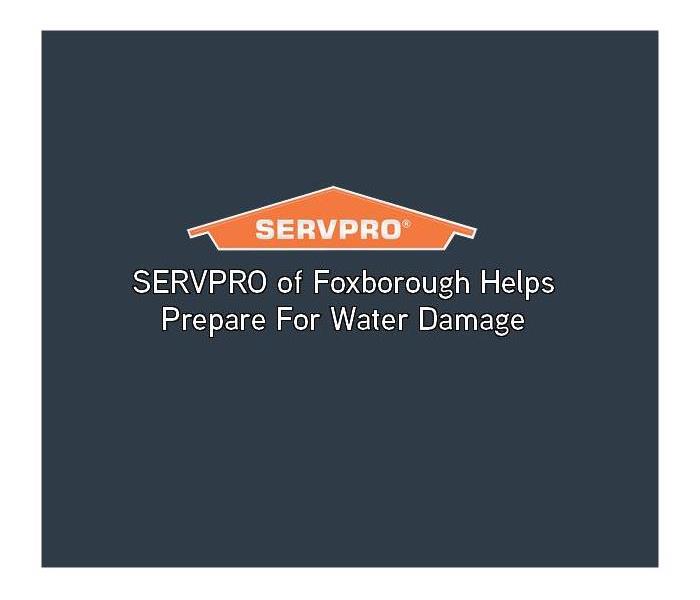 Freezing temperatures and accumulation of snow in winter can cause water damage.
Freezing temperatures and accumulation of snow in winter can cause water damage.
Freezing temperatures and accumulation of snow in winter can cause water damage. Water pipes can freeze and burst, ice dams can form on your roof, and many more issues can arise. There are safety measures to prevent water damage to your home in the winter.
Prevent Ice Dams
Ice dams are created when warm air in the attic heats the roof and melts the snow on the roof. You can prevent these:
- Have your gutters and downspouts cleaned, inspected. You want to make sure water will flow unobstructed in your drain system.
- Insulate your attic properly. The heat in your home should not reach the attic. Make sure the attic floor is airtight by sealing openings.
- Provide enough ventilation in the attic to keep the roof cool.
- Remove snow off your roof to prevent any water damage on the roof and into your home.
Other Winter Water Damage Safety Tips
- Install water leak detectors on sump pumps, near water-bearing fixtures, and beneath pipes.
- Inspect your hot water heater, washing machine, ice machine, and other appliances that can leak.
- Disconnect outdoor hoses in the winter months. Having your hoses disconnected will prevent water from freezing in the line.
SERVPRO of Foxborough is available 24/7 including holidays and weekends to assist you with any water damage “Like it never even happened.”
How A Sump Pump Can Prevent Water Damage
11/16/2021 (Permalink)
From snowmelt runoff to river flooding to summer storms, groundwater has the potential to affect Massachusetts properties no matter the season.
Because water naturally migrates through soil, elevated moisture on the surface can spell trouble for crawlspaces, unfinished basements, and even basements with concrete flooring. When groundwater penetrates the floor of a basement, it can lead to mold or mildew growth, and if the seepage is extreme, it can cause flooding and damage to your belongings.
So how do you keep your basement dry and mildew-free when those heavy rains strike? Installing a sump pump (or checking that your existing pump is in good working order) is one good option.
For houses at risk of underground wetness—which is over 60%, according to the American Society of Home Inspectors—sump pumps prevent damage by collecting that seeping groundwater and redirecting it to a discharge pipe pointed away from the structure’s foundation. To accomplish this, the pump sits in a pit dug at the lowest point of the basement or crawl space, and automatically turns on when the pit begins to fill with water. A one-way valve in the sump pump’s pipe, called a check valve, ensures that the water doesn’t run back.
While sump pumps are not a cure-all for water damage in every home, they are certainly a viable option for homes in a number of climates and terrains. If you’re concerned about dampness or the smell of mildew in your basement, call SERVPRO of Foxborough today. Our technicians can perform a dry-out and mold inspection of the space, as well as help pinpoint the source of water so you can safely move forward with adding preventative measures, and maybe even a sump pump.
Reduce The Risk Of Frozen Pipes
11/13/2021 (Permalink)
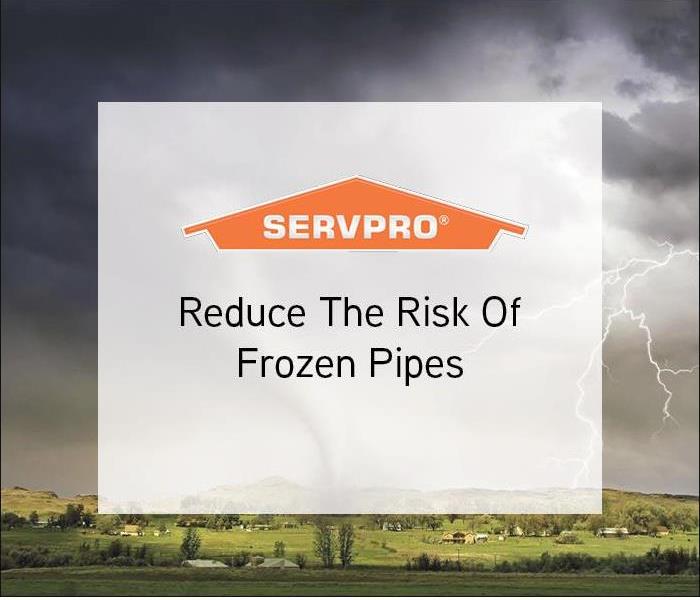 The winter months are here and that means the cold, freezing Foxborough weather.
The winter months are here and that means the cold, freezing Foxborough weather.
The winter months are here and that means the cold, freezing Foxborough weather. Unfortunately, with the cold weather comes the increased risk of the water in your home's pipes freezing. The expansion of the frozen water may cause damage to your home’s plumbing, or even rapture. Once the water thaws, your house will be flooded with water.
Here are steps that can be taken to minimize the risk of frozen pipes.
- Before temperatures reach freezing, insulate exposed and vulnerable pipes; install pipe sleeves or even wrap the pipes with newspaper.
- Close the garage door to prevent cold air from coming in.
- Open kitchen and bathroom cabinets to allow warm air to circulate around the pipes.
- Allow the cold water to slowly drip from one of your faucets.
- Keep your home heated above 55 degrees Fahrenheit.
- Get a generator because deep freezes regularly cause power outages.
SERVPRO of Foxborough is available 24/7 including holidays and weekends to assist you with any fire damage “Like it never even happened.”
Protect Your Property From Rainfall
11/13/2021 (Permalink)
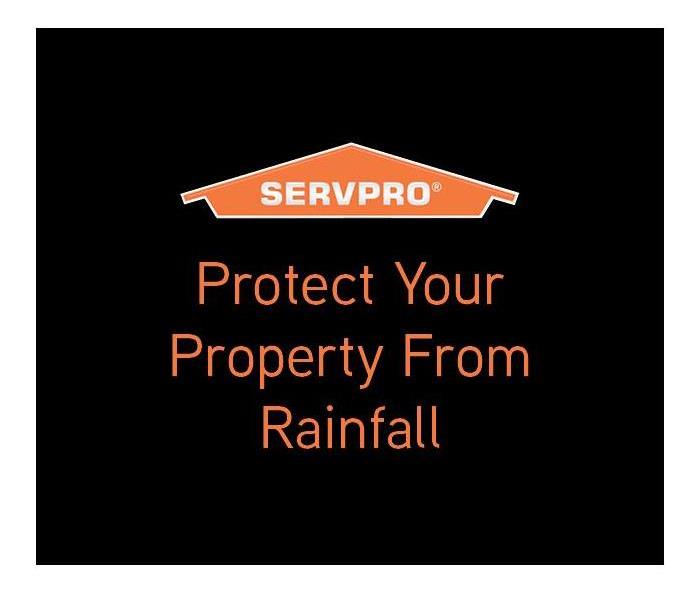 Heavy rain and storms can cause damage to your Bellingham, MA commercial or residential property.
Heavy rain and storms can cause damage to your Bellingham, MA commercial or residential property.
Heavy rain and storms can cause damage to your Bellingham, MA commercial or residential property. Storms can produce high winds and cause damage to your home. Even a small roof puncture or a cracked window from a tree limb can be enough to allow rainfall into your home. Heavy rain also raises the risk of flooding. The following tips will help keep your property safe and dry in the event of a storm:
- Consider options to protect your windows and entryways such as adding shutters and storm doors.
- Having a sump pump and dehumidifier handy can really help on days with heavy rain.
- Keep an eye on the trees closest to your home, sometimes damage can be prevented by trimming back the trees that pose a threat.
- Regularly check that rainwater is draining properly. If it isn’t, consider ways to redirect it such as adding gutters.
SERVPRO of Foxborough is available 24/7 including holidays and weekends to assist you with any fire damage “Like it never even happened.”
Flood Cuts in Water Damage Restoration
10/13/2021 (Permalink)
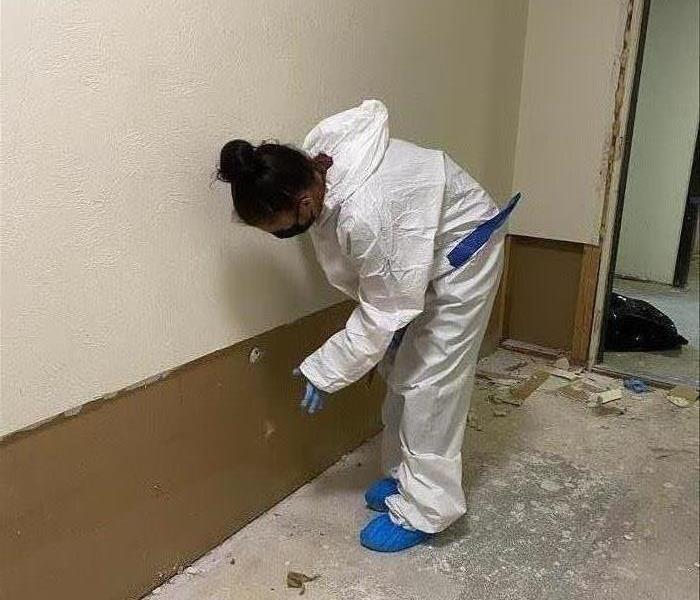 Katie, a production technician, working on an area where a flood cut was made.
Katie, a production technician, working on an area where a flood cut was made.
Water damage, if not treated quickly and efficiently, can damage flooring, walls/ceilings, and personal belongings. If proper mitigation steps aren't started within 24-48 hours, mold and mildew may begin to form. SERVPRO of Foxborough is here and "Faster to Any Size Disaster.”
During the water mitigation process some homes or businesses may require a flood cut. A flood cut is the simple process of cutting out drywall that has become saturated with water. These cuts, depending on the severity of damage, may be 2-4 feet from the floor.
By removing the saturated drywall the wall cavities are able to dry properly thus preventing potential hidden mold concerns. When our team of professionals performs these cuts they will ensure the cut is strait to aid in the reconstruction process. After the cuts have been made, SERVPRO technicians will remove all debris including the drywall and any insulation that needs to be removed as part of the drying process. In many circumstances, the wall cavities and studs remaining will be treated with an antimicrobial product to help prevent mold and mildew grow.
As an added benefit, SERVPRO of Foxborough has a rebuilds team that is highly experience in drywall, trim/finish work, and painting to help make the process seamless. Our goal is to remove as much stress from your plate as possible during this already difficult time. Rebuilds make our business a one-stop shop, ready to get our home back on its feet, to make the disaster "Like it never even happened."
A Little Amount Of Water Equals Significant Damage
12/10/2020 (Permalink)
Even small amounts of water damage can lead to significant damage to your Bellingham, MA commercial or residential property. The primary reason is DIY restoration. To the untrained eye, everything may look dried out but hidden moisture may remain which could cause a mold infestation. If you see visible mold, your best move is to leave it alone because when you disturb mold by trying to remove it you can inadvertently spread mold spores throughout your home. Mold spores are microscopic and when you try to clean them, the mold can release tiny spores which become airborne and can circulate inside your home.
What To Do
- Stay out of affected areas.
- Turn off the HVAC system and fans.
- Contact SERVPRO of Foxborough for mold remediation services.
What Not To Do
- Don’t touch or disturb the mold.
- Don’t blow air across any surfaces with visible or suspected mold growth.
- Don’t attempt to dry the area yourself.
- Don’t spray bleach or other disinfectants on the mold.
About Our Mold Remediation Services
SERVPRO of Foxborough specializes in mold cleanup and restoration; in fact, it’s a cornerstone of our business. Our Disaster Remediation Teams are highly trained restoration professionals with access to specialized state-of-the-art equipment. They are also trained in the proper techniques to remediate mold without cross contaminating unaffected areas of your property.
If you suspect your commercial or residential property has a mold infestation call the experts of SERVPRO of Foxborough at (508) 533-5305. We will make it, "Like it never even happened."
Getting To Know Ice Dams
12/10/2020 (Permalink)
One of the major causes of property damage during the winter months in New England are ice dams. Ice dams form on the eaves of sloped roofs. Freezing of melted snow at the eave impedes the drainage of melt-water, adding to the ice dam an so on. Because the drainage of the melt-water is impeded water may find its way under protective roofing materials and into the building.
How They Occur
Ice dams occur on heated buildings with sloping roofs in cold climates with deep snow accumulation. Ice dams on roofs form when accumulated snow forms an insulating layer under cold conditions that would cause the freezing point to be within the snow layer, if it were not subject to melting. Instead, building heat coming through the roof's surface melts the snow resting on it. This causes melt-water to flow down the roof, until it reaches below a place on the roof's surface that is below freezing—typically at the eaves where there is no building heat. When the melt-water reaches the frozen surface, ice accumulates, growing a barrier that impedes further passage of melt-water off the roof. Ice dams may result in leaks through the roofing material, possibly resulting in damaged ceilings, walls, roof structure and insulation, damage or injury when the ice dam falls off or from attempts to remove ice dams.
The melting of roof snow comes from the combination of three basic causes:
- Air temperatures well below freezing.
- A thick layer of dry snow, which has good insulating capabilities.
- Heat from the building coming through the roof.
Generally, ice dams occur when the under-roof temperature is above 30 °F (−1 °C) and the outdoor air temperature is below 22 °F (−6 °C).
Factors Of Increased Risk
While ice dams simply need the ideal weather conditions to form there are additional factors that will increase the likelihood of ice dams forming. They are:
- Old/damaged roofs
- Lack of or improperly installed rubberized asphalt underlayment
- Damaged or blocked gutters
- Insufficient or improperly installed insulation
When ice dams form on your commercial or residential property;
Do
- Clear all snow with a wheeled roof rake
- Place calcium chloride ice melt in panty hose, tie into small balls and place them in a row, approximately one foot apart, across the top of the ice dam
- If necessary us a rubber mallet to break the ice
- Hire a professional
Do Not
- Use a shovel to remove the snow
- Attempt to break the ice with a hammer or any hard object
- Use rock salts
- Any type of external heat source
If ice dams form on your commercial or residential property and cause water damage call the experts of SERVPRO of Foxborough at (508) 533-5305. We will make it, "Like it never even happened."
4 Causes Of Burst Pipes
11/16/2020 (Permalink)
Burst pipes are a common occurrence in the Commonwealth as the colder months set in. Many residents and workers are in buildings where the pipes are potentially older than their grandparents! When water pipes burst it may be preceded by a loud pop sound. Regardless, the result is can be major flooding in your Walpole, MA commercial or residential property. There are four main reasons why burst pipes occur:
- Frozen Pipes
- Moving Pipes
- Water Pressure
- Corrosion
Frozen Pipes
During the Winter months, serious issues can arise for the water supply pipes. Cold temperatures cause contraction to occur. Ice has more volume than water, so when water freezes inside a pipe it expands and increases pressure inside the pipe. The pressure builds resulting in a burst in the pipe. The burst will occur at the weakest point in the pipe, with pressure bursting right out of the side of the pipe wall.
To prevent frozen pipes, make sure that the temperature inside your property stays above 55 degrees Fahrenheit.
Moving Pipes
Pipes can actually move around within the walls if they’re not properly secured especially when the water is suddenly turned on or off. One way to know for sure is if you can hear your water pipes making noise inside the walls or floors. If your pipes sound like they’re clanging against each other, it’s called a water hammer. What you’re hearing is that the pipes are moving back and forth due to not being held into place properly. Gradually, these pipes become weakened in the joints until one pipe fails. This causes the water pipe to break and flood your property.
Water Pressure
Water pressure must be kept at a normal setting in order for your water supply pipes to function properly. Any noticeable increase in the water pressure can translate to a burst pipe. As pressure increases, the pipes will cave in and separate, causing a rupture. Not sure if your water pressure is above too high?
- The water pressure in most homes is between 30-50 psi to avoid damage to pipes and plumbing fixtures.
- Monitor it by attaching a pressure gauge to a sink spout and turning on the faucet. The pressure will move the needle on the gauge and display the water pressure in psi (pounds per square inch).
- If your home’s water pressure is too high, a SERVPRO of Foxborough technician can install a pressure reducing valve to bring it down to safer levels.
CORROSION
Pipes are meant to last a long time and provide decades worth of reliable service, but they do not last indefinitely. Over time, buildings experience corrosion which can mean that pipes will show signs of failure or decay. Corrosion is caused by an imbalance of pH in the water. At first, this seems to be a minor issue, but it takes its tolls on the pipes over the years.
Many water supply pipes are made of galvanized iron, the minerals inside the water slowly wear down the galvanized coating and expose the iron pipe beneath. In time, the iron turns to rust and gradually clogs the interior of the pipe which prevents water from getting through. As a result, your pipe may burst or the water flow may be stopped entirely.
If you experience a burst pipe, the first step is to turn off the Water Main. Then call the water remediation experts of SERVPRO of Foxborough to remediate the water damage. and to determine the cause of the burst pipe at (508) 533-5305. We will make it, "Like it never even happened."
5 Commercial Property Water Risks
11/13/2020 (Permalink)
When the weather turns extreme, it’s natural to worry about water damaging your Walpole, MA commercial property. Unfortunately, even when the weather is seemingly perfect, there are other culprits that can cause water damage. Here are five potential causes of water issues to watch out for.
Plumbing
A broken pipe can happen for numerous reasons, including freezing temperatures, pressure changes, water supply deterioration. Water stains, bulging walls, musty odors, or damaged tiles are indicators that there may be a leaking pipe that requires a water repair.
Sprinkler System Issues
Vital as the first line of defense, if not properly maintained, a sprinkler system can lead to extensive damage, especially if a broken pipe is the issue. Along with accidental activation, which results in 100s of gallons of water pouring down, neglected systems can slowly leak.
Faulty Appliances or Equipment
Along with major systems like HVAC and water heaters, any dishwasher or equipment that uses water on the property could be the source of a lingering musty odor. Regular maintenance, inspections, and cleaning are necessary to keep them working properly.
Sewer and Toilet Backups
Regardless if the cause is improperly flushing items, flooding overfilling the sewer drain or issues with the city’s mainline, toilet and sewer water is not regular water. Full of contaminants, cleaning it up requires extra considerations. If these types of issues arise, it’s best to call a trusted plumber to determine the problem to help keep it from happening again.
Structural Damage
Buildings may be built to last, but they are not invincible. Any part of it not doing what it should could let water seep in. Before the next rain, inspect the building for broken windows, leaky roofs, and foundation issues. Improper drainage, such as clogged gutters, can quickly lead to big foundational problems.
Regardless of the cause, immediately addressing the water damage is necessary to limit the destruction. If water has damaged your commercial property call the water remediation experts of SERVPRO of Foxborough of (508) 533-5305 today! We will make it "Like it never even happened."
Protect Your Property From Rainfall Damage
11/12/2020 (Permalink)
Heavy rain and storms can cause substantial damage to your Bellingham, MA commercial or residential property, especially if you aren't prepared. Storms can produce high winds causing fallen branches, and trees. There is always the possibility that when a storm hits, there will be damage to a property. Even a small roof puncture or a cracked window from a tree limb can be enough to allow rainfall to trickle (or pour) into your home. A downed tree can cause serious damage to your roof, siding and windows. Heavy rain also raises the risk of flooding. The following tips will help keep your property safe and dry in the event of a storm:
- Consider options to protect your windows and entryways such as adding shutters, rain diverters and storm doors.
- Having a sump pump and dehumidifier handy can really help on days with heavy rain or high humidity.
- Keep an eye on the trees closest to your home. Of course, you don’t want to cut into every tree but sometimes damage can be prevented by trimming back the trees that pose a threat.
- Regularly check that rainwater is draining properly. If it isn’t, consider ways to redirect it such as adding gutters or consulting a contractor.
- Regularly check your home for potential weaknesses especially in the roof, siding and windows. Even a small opening can let in rainwater so catching and repairing these issues before a storm hits is important and will save you money.
If water has damaged your commercial or residential property call the water remediation experts of SERVPRO of Foxborough of (508) 533-5305 today! We will make it "Like it never even happened."
Even Small Leaks Can Lead To Large Losses
10/13/2020 (Permalink)
Even the smallest spills and leaks can lead to major damage in your Foxborough, MA residential or commercial property. Not properly cleaning up after a spill can cause mold growth. Ignoring a small water leak can, over time, can cause damage to building materials such as floors, walls, insulation and may even result in structural damage.
Not every water spill is serious enough to call a professional water cleanup company, but it's important for you to know how to properly take care of any spills or small leak. If you act fast and understand how to clean up, you can prevent any secondary damage.
For example, a fish tank that leaks or breaks and a gallons of water spill onto the floor. Here are some of the things you'll need to properly clean the area:
- Shop vacuum (wet/dry vac)
- Pumps
- Towels
- Box fan/s
- Air movers
- Dehumidifier - If you don't have one you can rent from your local tool rental business. It's best to have an industrial strength dehumidifier, but in a pinch a household is better than no dehumidifier at all.
Most property owners may have some of the necessary tools and may even think that is enough. Unfortunately, that is usually not the case. There are no short cuts to take during the drying process.
As soon as you see the spill, and IF IT IS SAFE TO DO SO:
- Identify and stop the source of water
- Cleaning up the mess right away with a a pump or shop vacuum if you have one
- Use towels to dry the rest of the water
- ONLY IF ALL WATER HAS BEEN REMOVED AND IT IS SAFE TO DO SO, place box fans or a dehumidifiers near the damaged area and them on.
The fact is that it is NOT always safe to clean up water damage. From contaminated water to the possibility of electrocution the risk of harming oneself is real. That is why you need the help of certified professionals.
If water has damaged your commercial or residential property call the experts at SERVPRO of Foxborough. We will make it "Like it never even happened," at (508) 229-2061 for remediation services.
SERVPRO of Foxborough, Your Water Remediation Experts
11/20/2019 (Permalink)
Untouched water damage will cause havoc.
Many times, leaking pipes cause water damage in a home. When it goes unnoticed, a large volume of water can discharge over a short period, which can cause significant damage depending on the location of the leak. If you notice such an issue, turn off the water supply first.
It is also vital to locate and repair the leak and remove ruined items from the affected area. If the point of the leak that caused water damage in your Foxborough residence is concealed, we will use a thermal imaging camera to locate it. Your insurer may request you locate the point of the leak and provide the details in the documentation used to file a claim. Turning off the electricity to the affected areas is also vital for this can prevent electrocution hazards.
The Disaster Remediation Team at SERVPRO of Foxborough will immediately dry the affected areas. We have the right equipment for the job, such as wet/dry vacuum cleaners, pumps, air movers and dehumidifiers. We identify the extent of water loss and use structural drying techniques to dry the affected areas thoroughly. We determine what should be done, monitor and document the drying process with accurate measurements and recorded data.
After we dry the affected areas, our Rebuild Team will begin the restoration tasks required to return the property to its preloss condition. Restoration work may include cleaning, reinstalling or repairing floors and floor coverings like carpets, carpet pads, hardwood flooring, and resilient or non-resilient floors. We can also install tack strip, seam carpets, repair or replace subfloors and refinish structural materials like ceilings, walls, the plates behind baseboards, framing, insulation, and vapor barriers and more! Once complete, we perform final cleaning and inspections. SERVPRO of Foxborough technicians will not close out a job until they ensure that the work meets our client's satisfaction.
If water has damaged your commercial or residential property call SERVPRO of Foxborough. We will make it "Like it never even happened!" at (209) 477-3090 for remediation services.
Steps To Follow When Your Property Floods
10/17/2019 (Permalink)
What do you do when your basement or place of business floods? Not knowing where to start and what to do can be overwhelming. Here are three steps to follow which will guide you through the process.
3 Steps to Cleanup Flood Damage
- Remove Water
Before any repairs can be made, all of the water must be removed from the basement. We at SERVPRO of Foxborough are water remediation experts and we can help you through the entire process. From water removal to rebuild our vast team of certified technicians and licensed craftsmen will make it “Like it never even happened.” Flooded basement water removal may look something like the following:
- Hiring an electrician to evaluate the risk of electric shock.
- Getting the sump pump up-and-running to remove sitting water.
- Using a shop vacuum to suck-up the last inch or so of water.
- Lifting carpet and using large fans to dry-out moisture.
- Sanitizing with warm water and disinfectant to prevent mold growth.
2. Repair Damage
Once the area has been completely dried, repairs may be in order. Checking your home flood insurance coverage may be a good place to start. While salvaging some belongings may be an option, it is unwise to try to save anything which uses electricity or gas. If your gas furnace or electric outlets took on water in the flooding, replacement over repair is the safe route to go.
- Plan for Future Flood Prevention
Now that the basement is clean, dry, and repairs are complete its time to plan ahead for the future. There is nothing worse than putting time and money into basement flood restoration only to have it ruined all over again. Consider the following preventative measures:
- Install a back-up pump.
- Create outside drainage for storm runoff.
- Buy a generator for use during a power outage.
While following these three tips will help you after water damage strikes the reality is calling SERVPRO of Foxborough is the only step you need to take!
What's Covered?
6/26/2018 (Permalink)
When is comes to water damage issues the best way to know what is covered and what isn't is to check your policy or ask you insurance agent.
Here is a standard list of what may or may not typically be covered. Remember everyone's policy is different and the best person to answer your coverage questions is always your agent!
- Burst Pipes and Leaks – Typically Covered
-Water Damage From Appliances – Typically Covered
- Roof Leaks – Typically Covered
- Flood Damage – Typically Not Covered
- Backed Up Drain or Sewer Line – Typically Not Covered
- Ground Water Seepage – Typically Not Covered
- Mold – Possibly Covered
If you or a friend has experienced water damage due to any of the above listed issues give our office a call. We are available 24 hours a day to help with all your water damage needs.
SERVPRO of Franklin/Walpole - 508-533-5305
Water Damage Timeline
6/26/2018 (Permalink)
When it comes to water damage it is never a good idea to wait. Check out this timeline to see what typically happens during a water damage.
Water Damage Timeline
Within Minutes
- Water quickly spreads throughout your property, saturating everything in its path.
- Water is absorbed into walls, floors, upholstery, and belongings.
- Furniture finishes may bleed, causing permanent staining on carpets.
- Photographs, books, and other paper goods start to swell and warp.
Hours 1 - 24:
- Drywall begins to swell and break down.
- Metal surfaces begin to tarnish.
- Furniture begins to swell and crack.
- Dyes and inks from cloth and paper goods spread and stain.
- A musty odor appears.
48 Hours to 1 Week:
- Mold and mildew may grow and spread.
- Doors, windows, and studs swell and warp.
- Metal begins to rust and corrode.
- Furniture warps and shows signs of mold.
- Paint begins to blister.
- Wood flooring swells and warps.
- Serious biohazard contamination is possible.
More Than 1 Week:
- Restoration time and cost increase dramatically; replacing contaminated materials and structural rebuilding may be extensive.
- Structural safety, mold growth, and biohazard contaminants pose serious risks to occupants.
Understanding Category and Class during water Damage.
6/25/2018 (Permalink)
According to the IICRC S500 Standard and Reference Guide for Professional Water Damage Restoration
There are 3 Basic Categories of Water
Category 1 originates from a sanitary source and poses no substantial risk from dermal, ingestion, or inhalation exposure. However, it may not always remain clean after it comes into contact with other surfaces or materials.
Category 2 contains significant contamination and has the potential to cause discomfort or sickness if contacted or consumed by humans. It may contain potentially unsafe levels of microorganisms or nutrients for microorganisms, as well as other organic or inorganic matter (chemical or biological).
Category 3 is grossly contaminated and may contain pathogenic, toxigenic or other harmful agents. Such water sources may carry silt, organic matter, pesticides, heavy metals, regulated materials, or toxic organic substances.
Time and temperature can also affect the quality of water, thereby changing its category. *Refer to the IICRC S500 for complete definitions.
The 4 Primary Classifications of Water Damage
Class 1 is the least amount of water, absorption and evaporation. It affects only part of a room or area, or larger areas containing materials that have absorbed minimal moisture. Little or no wet carpet and/or cushion is present.
Class 2 involves a large amount of water, absorption and evaporation. It affects at least an entire room of carpet and cushion (pad). Water has wicked up walls less than 24 inches. There is moisture remaining in structural materials and substructure soil.
Class 3 involves the greatest amount of water, absorption and evaporation. Water may have come from overhead. Ceilings, walls, insulation, carpet, cushion and subfloor in virtually all of the entire area are saturated.
Class 4 relates to specialty drying situations. Wet materials with very low permeance/porosity (eg. hardwood, plaster, brick, concrete, light-weight concrete and stone). Typically, there are deep pockets of saturation, which require very low specific humidity. These types of losses may require longer drying times and special methods.
*Refer to the IICRC S500 for complete definitions.
Are YOU in HOT WATER?
4/6/2018 (Permalink)
Often times homeowners aren't aware that a Hot Water Heater is about to fail. Most often you are met with water running out from under your foundation, or garage!
While you can't be sure when failure will occur, there ARE signs you can keep an eye out for.
Knowing the age of your water heater is one way, which can be located by looking at the manufacture sticker on the upper portion of the water heater.
Example if the Serial number is F051052638, the "F" represents the month, since "F' is the sixth letter of the alphabet it was manufactured in the month of June.
The next two numbers represent the year. Since 05 are the two numbers following the "F" this means the hot water heater was built in 2005.
A good rule of thumb: Most hot water heaters over 10 years old have lived a useful life and should be considered for replacement.
If you have suffered a Hot Water Tank failure, SERVPRO of Franklin/Walpole is at your service to assist with YOUR water clean up! ~ Faster in Any Size Disaster ~ Available 24/7
Faster to any Size Disaster
8/28/2017 (Permalink)
Flooding and water emergencies don’t wait for regular business hours and neither do we. SERVPRO of Franklin/Walpole provides emergency cleaning and restoration services 24 hours a day, 7 days a week—including all holidays.
Faster To Any Size Disaster
Flooding and water damage is very invasive. Water quickly spreads throughout your home and gets absorbed into floors, walls, furniture, and more. SERVPRO of Franklin/Walpole arrives quickly and starts the water extraction process almost immediately. This immediate response helps to minimize the damage and the cleaning and restoration costs.
Need Emergency Service? Call Us 24/7 – 781-341-1946
Water Damage Timeline
Within Minutes
- Water quickly spreads throughout your property, saturating everything in its path.
- Water is absorbed into walls, floors, upholstery, and belongings.
- Furniture finishes may bleed, causing permanent staining on carpets.
- Photographs, books, and other paper goods start to swell and warp.
Hours 1 - 24:
- Drywall begins to swell and break down.
- Metal surfaces begin to tarnish.
- Furniture begins to swell and crack.
- Dyes and inks from cloth and paper goods spread and stain.
- A musty odor appears.
48 Hours to 1 Week:
- Mold and mildew may grow and spread.
- Doors, windows, and studs swell and warp.
- Metal begins to rust and corrode.
- Furniture warps and shows signs of mold.
- Paint begins to blister.
- Wood flooring swells and warps.
- Serious biohazard contamination is possible.
More Than 1 Week:
- Restoration time and cost increase dramatically; replacing contaminated materials and structural rebuilding may be extensive.
- Structural safety, mold growth, and biohazard contaminants pose serious risks to occupants.
Hot water tank failure - Belingham, MA
5/15/2017 (Permalink)
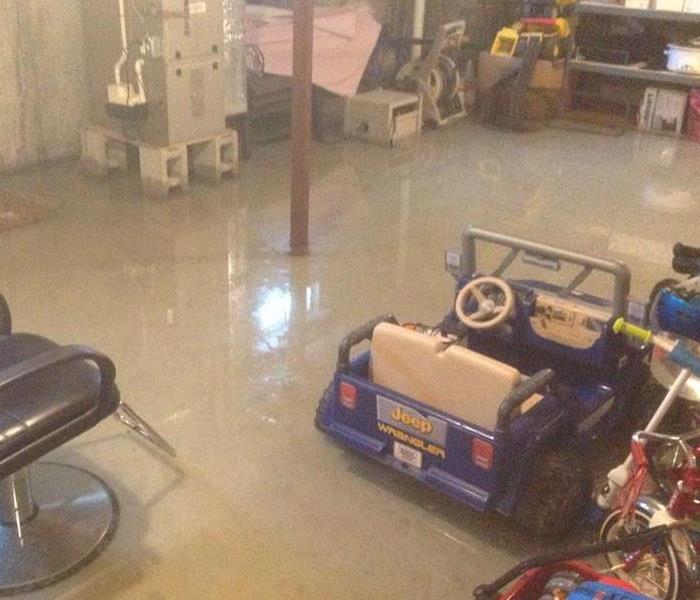 This homeowner suffered a water loss when the hotwater tank failed.
This homeowner suffered a water loss when the hotwater tank failed.
Most often homeowners aren't aware that a hot water heater is about to fail. Most time you are met with water running out from under your foundation, or garage. While you can't be sure when failure will occur, there are signs that you can keep and eye out for.
Knowing the age of your water heater is one way, which can be located by looking at the manufacture sticker on the upper portion of the water heater. Example if the Serial number is F051052638, the "F" represents the month, it's the sixth number of the alphabet so it was manufactured in June. The next two numbers represent the year. So since 05 is the two numbers following the "F" this means the heater was built in 2005. A good rule of thumb is most hotwater heaters over 10 years old have lived a useful life and should be considered for replacement.
If you have suffered a hot water tank loss, call SERVPRO of Franklin/Walpole at 508-533-5305 to assist with your water clean up.
A/C water loss - Carver, MA
5/15/2017 (Permalink)
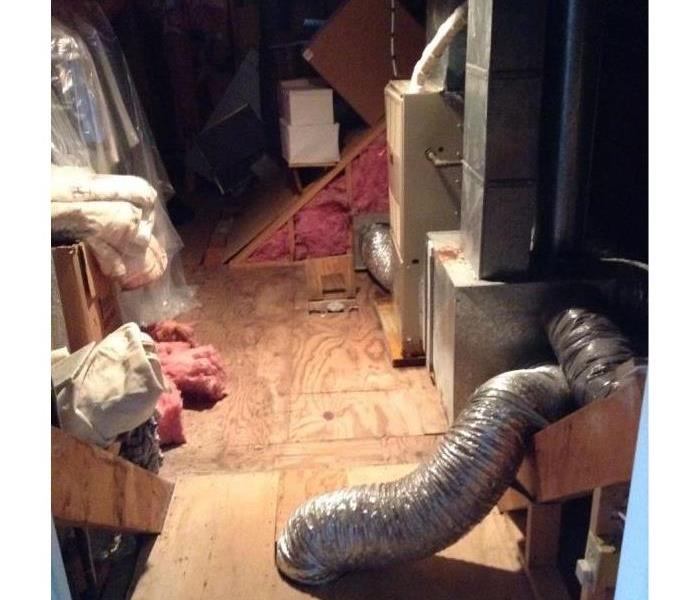 This homeowner suffered a water loss when his A/C unit line failed.
This homeowner suffered a water loss when his A/C unit line failed.
As a homeowner when you have central air conditioning you wonder if there are early signs that your central air conditioner is failing. We all expect our central air conditioners to work as soon as we flip a switch but sometimes nothing happens. Here are a few signs to look out for.
No Power: It could be the result of a blown fuse or tripped circuit breaker, ore a bad thermostat.
Not Cooling. If the unit is running but seems to be warm air, it could be from a refrigerant leak. Check for signs of moisture in the ceiling and the walls.
If you believe that you have suffered leakage from your central air conditioning unit call SERVPRO of Franklin/Walpole at 508-533-5305 to remediate the loss quickly.
Toilet tank loss - Taunton, MA
4/11/2017 (Permalink)
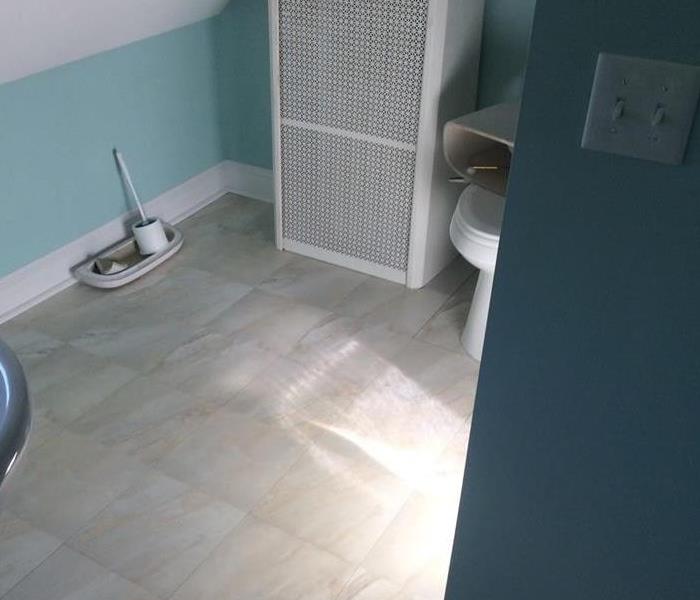 This homeowner suffered a water loss from his leaking toilet tank.
This homeowner suffered a water loss from his leaking toilet tank.
Nothing is worse than the experience of a leaky toilet. Chances are pretty good that you will deal with a cracked or broken toilet tank at least once in your life time.
There are many reasons why your toilet tank may break, but generally it is due from age. As a toilet gets older, it becomes more prone to cracking.
Any repairs you do on your toilet may cause cracking of the tank, or by simply placing the toilet tank cover on may also cause cracking.
If your toilet suffered a sudden impact, a hair dryer dropping, falling into the toilet could cause your tank to leak.
Toilets have also been known to leak at the gasket. As your toilet ages so does that gasket. The gasket is supposed to help create a seal between the toilet and the plumbing lines in your home. If you notice that your toilet leaks when you flush it, it is probably a worn gasket.
If you suffer a water loss from your toilet contact SERVPRO of Franklin/Walpole at 508-533-5305 and let us help.
Washing Machine Hose Failure
3/23/2017 (Permalink)
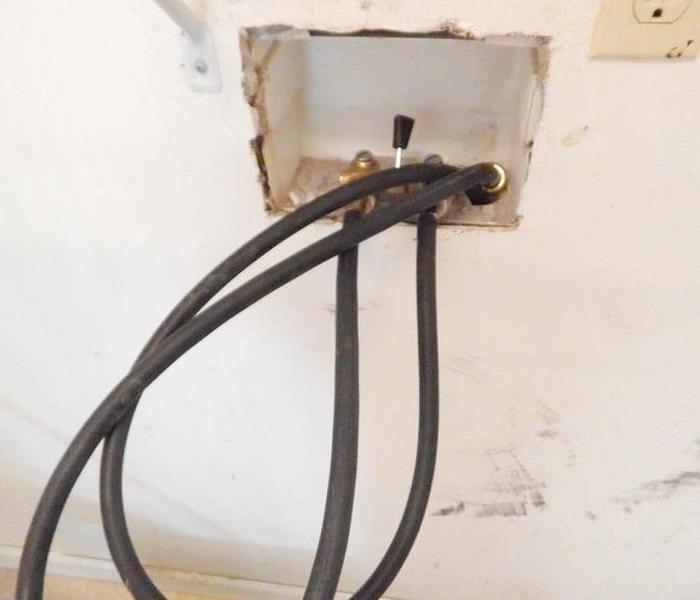 This homeowner suffered a severe water loss when the hose had broken away from the clamp.
This homeowner suffered a severe water loss when the hose had broken away from the clamp.
One of the top 10 sources of water damage to the home is from a failed water supply hose. As a homeowner conducting monthly inspection of the hot and cold water line could save you from losses you may suffer. The following are some steps to take to keep a water loss from happening.
- Look for sign the supply hose may be ready to fail. Blisters in the hose, worn tubing, or cracks.
- replace the supply hose with reinforced steel braided hose
- Make sure connections are tight. Replace them if they feel loose.
- Supply hoses should be replaced every 5 years even if there is no obvious deterioration.
Should you suffer a water loss contact SERVPRO of Franklin/Walpole at 508-533-5305. All our technicians have been trained and certified to handle all your water loss.
Pipe Burst Randolph, MA
3/23/2017 (Permalink)
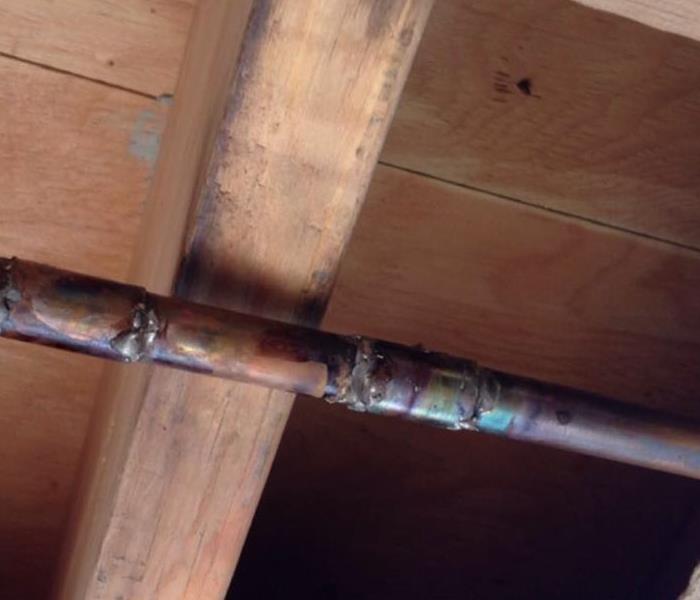 This homeowner was unaware a pipe had burst until they arrived back home
This homeowner was unaware a pipe had burst until they arrived back home
There are a number of potential reasons why pipes inside your home can break open, causing major flooding throughout. Some of the common causes are as follow:
EXTREMELY COLD TEMPERATURES:
When temperatures outside your home it can cause serious issues with your pipes. Ice has more volume than water so when water freezes inside a pipe, it expands and increases pressure inside the pipe, causing the pipe to split open.
MOVEMENT/WATER HAMMER:
If waster pipes aren't secured, they can move around inside the walls and when water is suddenly turned on or off. This can gradually weaken the joints in the pipe until one fails and allows pressurized water to escape the pipe, causing a catastrophic and expensive damage.
CORROSION:
Pipes are meant to last a long time, and many provide decades of reliable service. However, that doesn't mean pipes will last indefinitely. When the water has an imbalanced ph level the minerals inside the water slowly wear down the galvanized coating and expose the iron in the pipe causing it to rust over time.
If you experience a bust pipe contact SERVPRO of Franklin/Walpole at 508-533-5305.
Commercial/ Residential Restoration Services
6/29/2016 (Permalink)
Commercial/Residential Restoration and Cleaning Services
SERVPRO of Franklin/Walpole is a trusted leader in the restoration industry and has the training, equipment, and expertise to handle your restoration and cleaning needs. As a locally owned and operated business, we can provide 24-hour emergency service and are dedicated to responding immediately to commercial or residential needs.
24-Hour Emergency Service
Faster to Any Size Disaster
Highly Trained Restoration Technicians
A Trusted Leader in the Restoration Industry
Locally Owned and Operated
Advanced Restoration and Cleaning Equipment
Have Questions? Call Us Today (508) 533-5305
Residential Services
Whether you need emergency flood restoration or just need your upholstery cleaned, SERVPRO has over 1,650 Franchises ready to respond faster to any size disaster. SERVPRO of Franklin/Walpole has advanced equipment and highly trained technicians to make it “Like it never even happened.” We can help you with the following Commercial/Residential services:
Water Damage Restoration
Fire Damage Restoration
Mold Remediation
Storm Damage Restoration
Cleaning Services
Building Services
Make sure your home is protected this Spring
4/7/2016 (Permalink)
Spring time is right around the corner and although we are ready for the nice weather, most of us are not ready for the storms and flooding. Instead of letting the storm and flood damage take over your Nashville home, we can be proactive and make sure that we’re ready for the unexpected weather to hit. According to Rytech, there are 5 points to keep in mind when protecting your home from flooding this spring.
Check for leaks ahead of time on your own before finding them during a storm. Take matters into your own hands and use the hose lightly to test any suspicious areas that may have caused issues in the past to find out where the leaks may be happening.
Roof flashing is installed below the first course making sure that the flow of water is directed away from openings, keeping water out of your home and from deteriorating the walls. It’s always a good idea to have your roof professionally inspected annually to check for damage.
Basements are the most common area to flood in a home, being located at the very bottom, so it’s always a good idea to look into a sump pump to protect your assets. If you have a sump pump already, make sure to check for any damage or signs of failure. (Irreplaceable items should be placed higher up or even on a different floor in case of unexpected weather events.)
Make sure to keep the gutters cleaned to eliminate constant water flow down the exterior of the home causing possible leaking into the home.
Last, but not least, compare the costs to the risks. Many people hold off on putting some extra cost into making their home more water resistant due to cost, but the cost of cleaning up the damage after the incident is usually much more expensive.
Don’t let the storms cause water and flood damage in your home
4/7/2016 (Permalink)
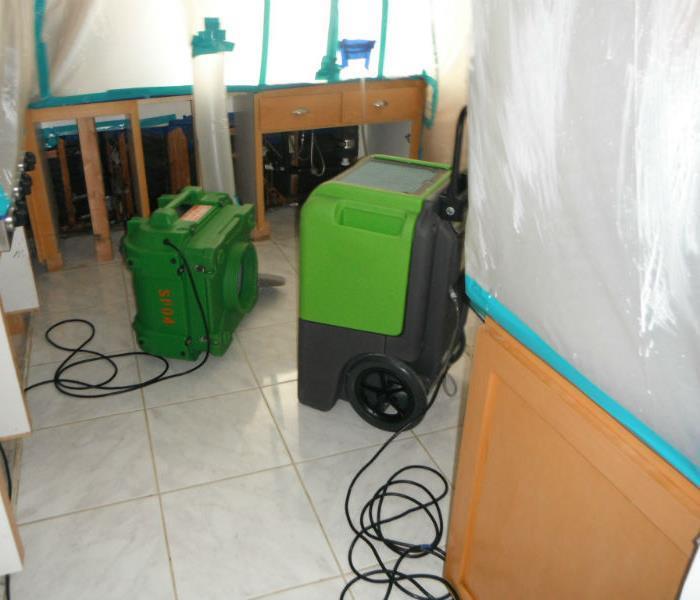 Drying out flood damage Source
Drying out flood damage Source
With storm season underway, there are unfortunate cases of flooding and power outages taking place all over. The humidity and flooded areas create a perfect combination and environment for mold to grow, giving you more than just flood damage to take care of. The sooner the water damage is cleaned up, the less likely there is a chance for mold to produce, leaving you with less to cleanup in the end.
Flood damage cleanup
1. Remove furniture and upholstery to clean or repair separately.
2. Start by using a wet/dry vacuum to get rid of as much water as possible so the water is not sitting.
3. Use fans to circulate air and speed up the drying process. A dehumidifier can also be used to remove the excess moisture in the air to prevent mold growth.
4. Once the water and moisture is cleared, start cleaning and treating the carpet and flooring throughout the flooded area. Steam clean any carpeted area to properly sanitize and check the padding under the carpet to ensure that it does not need replaced. Carpet padding usually needs replaced when a flood occurs.
5. Clean walls and baseboards with warm water and soap to remove any residue. Then apply bleach and water mixture to sanitize the surface.
Water damage produced from a flood can be dangerous and cause illness due to the bacteria sitting in the water. It’s important to act quickly when it comes to flood and water damage to prevent illness and worse damage to occur.
SERVPRO® of Franklin/Walpole understands the importance of keeping your home happy and healthy. If you have any questions or concerns regarding mold in your home call 508-697-5439 or visit www.SERVPROfranklinwalpole.com to schedule a free estimate today!




 24/7 Emergency Service
24/7 Emergency Service

























